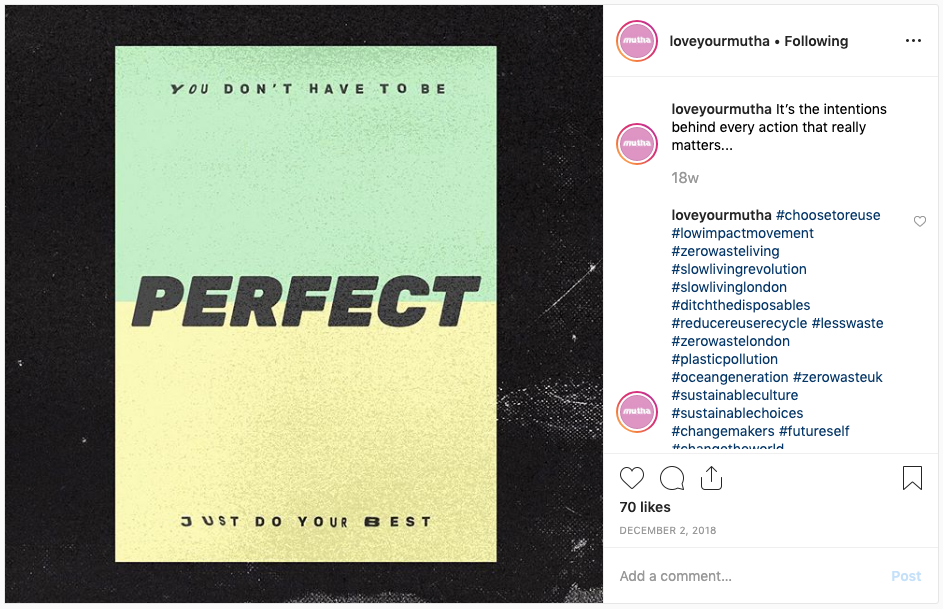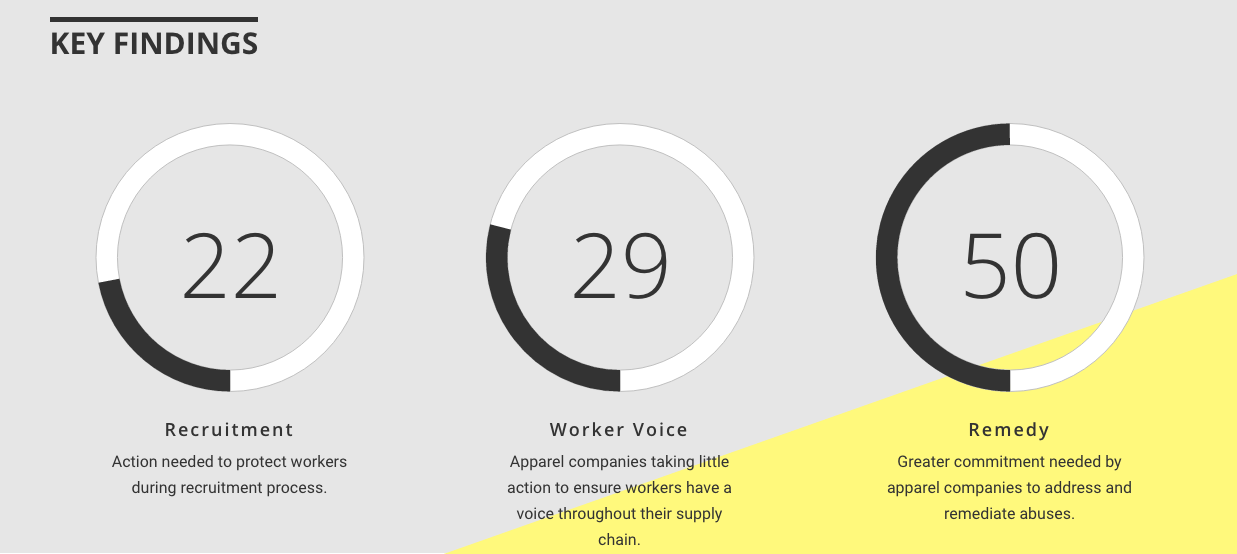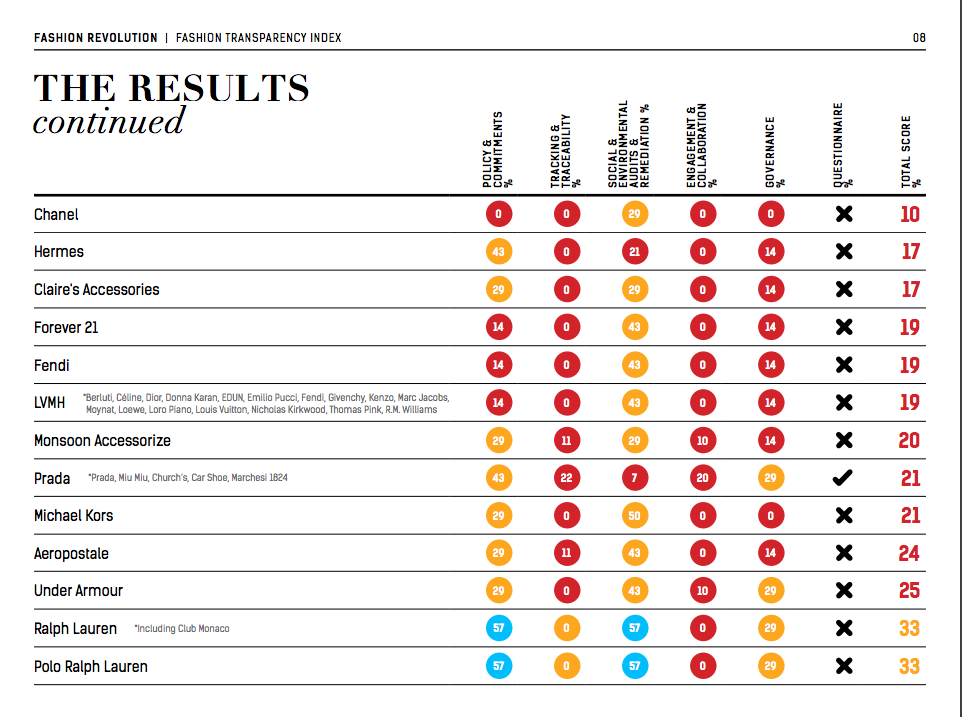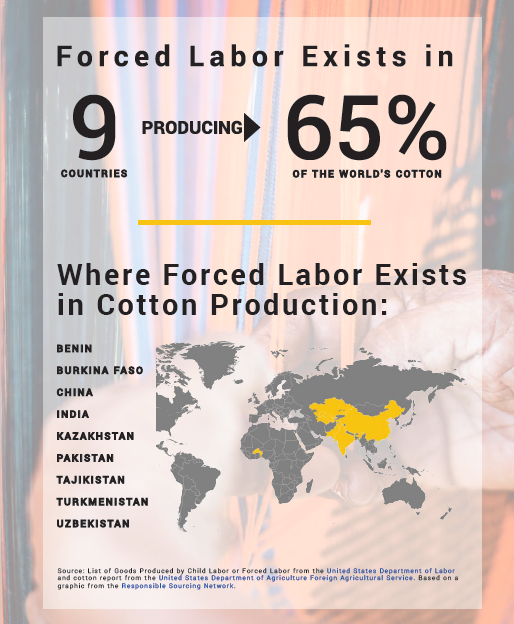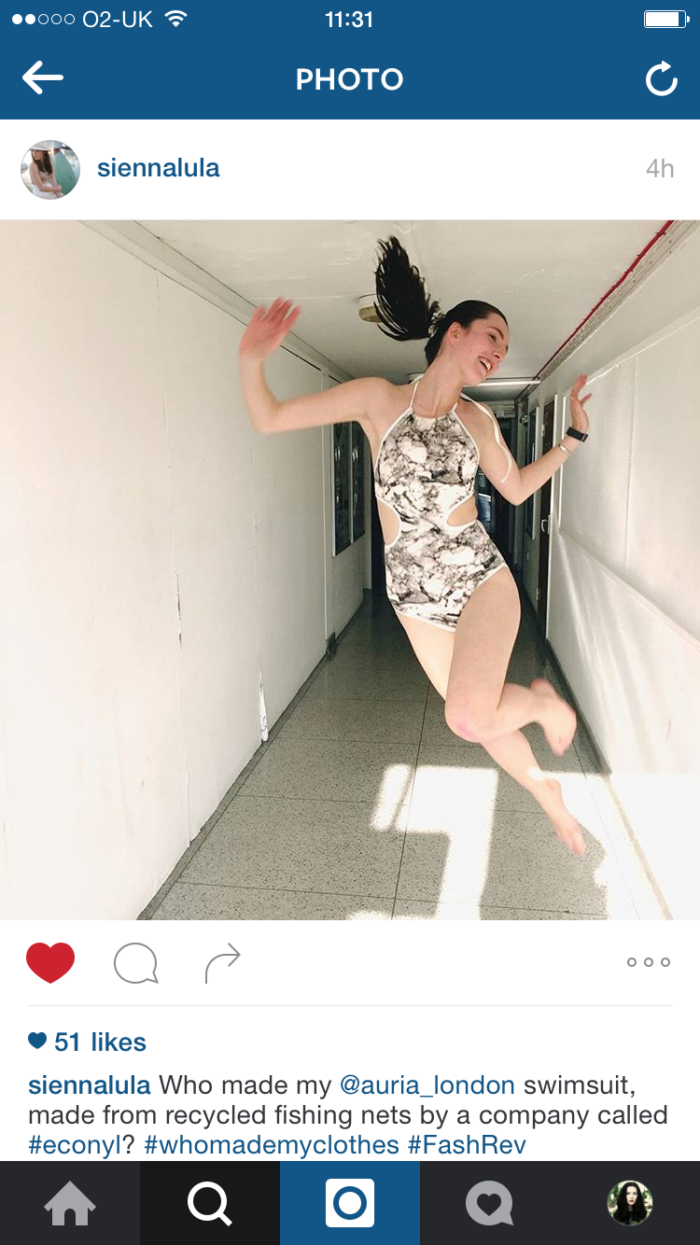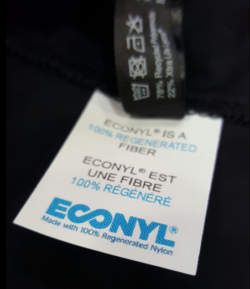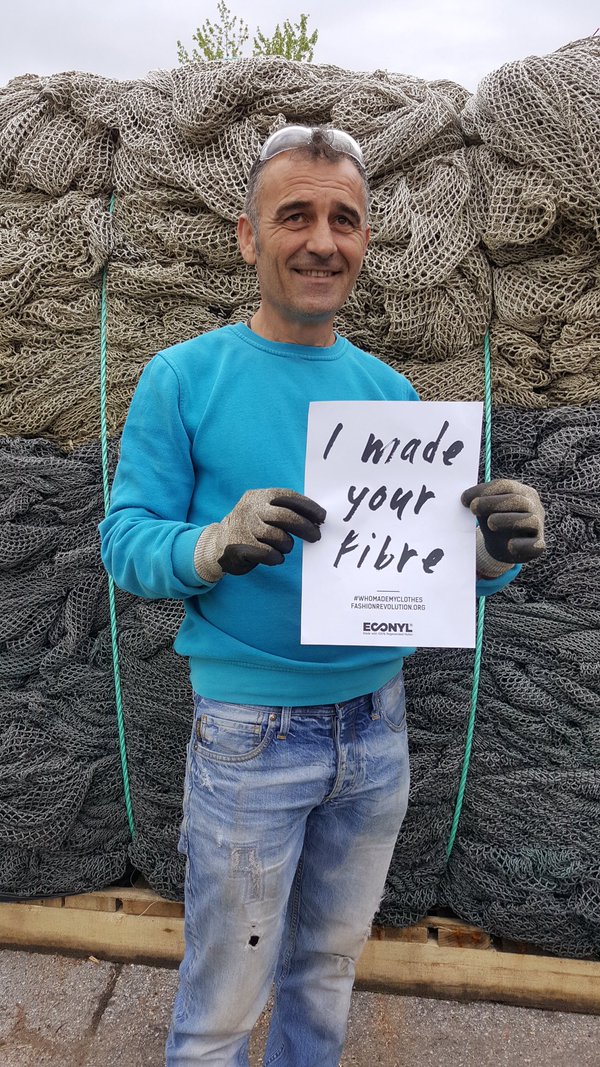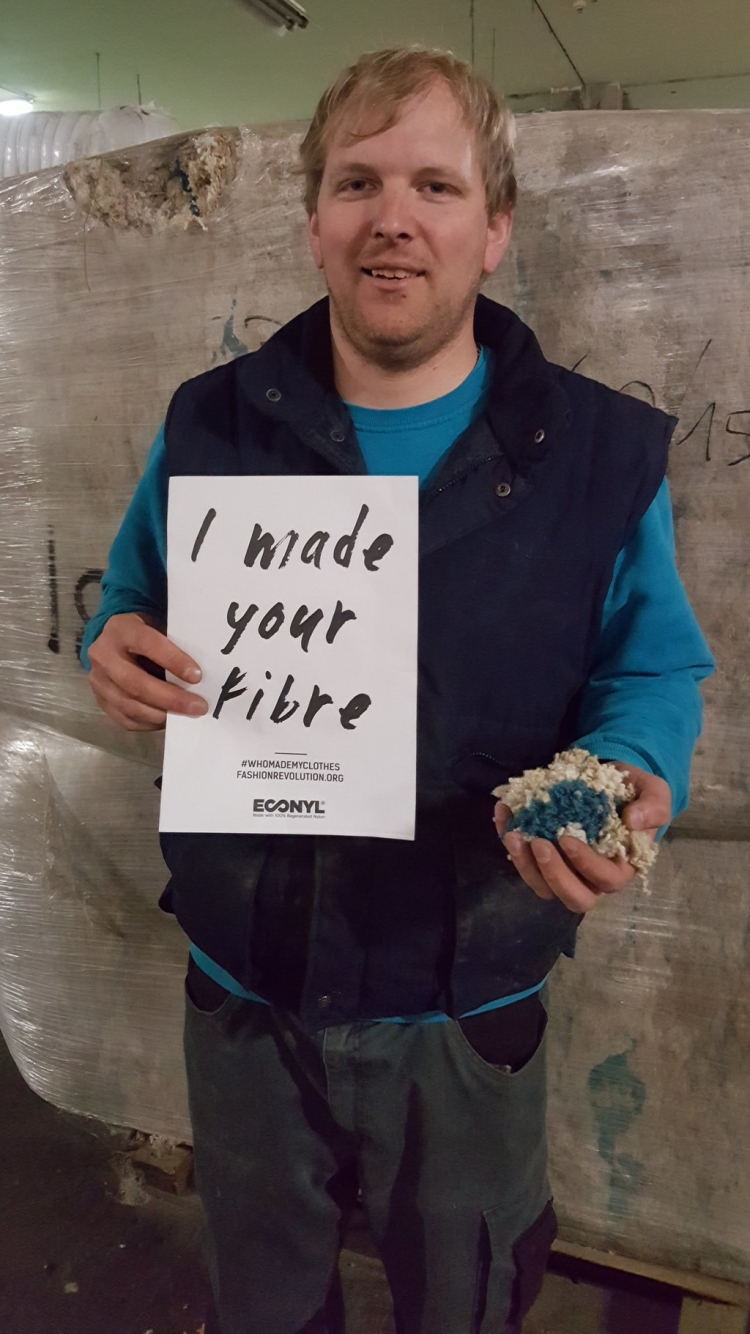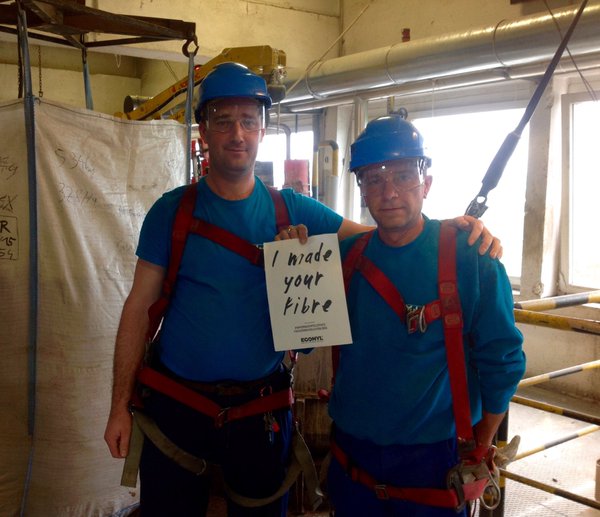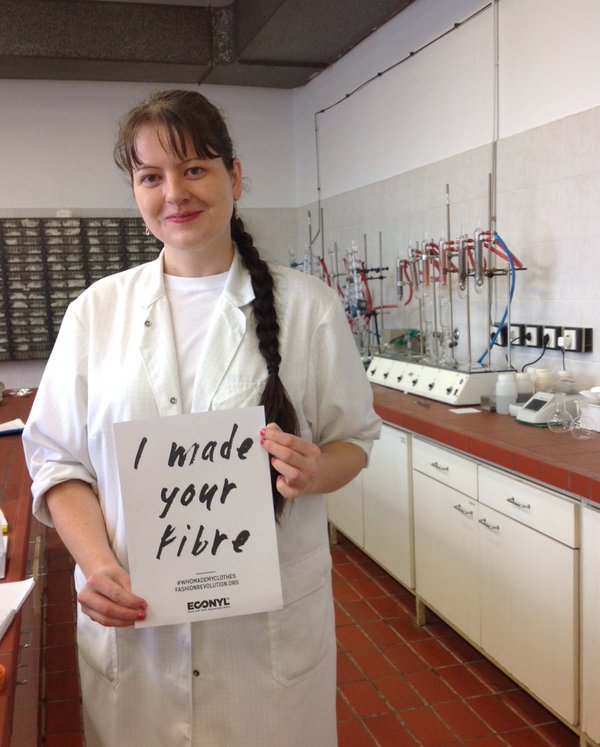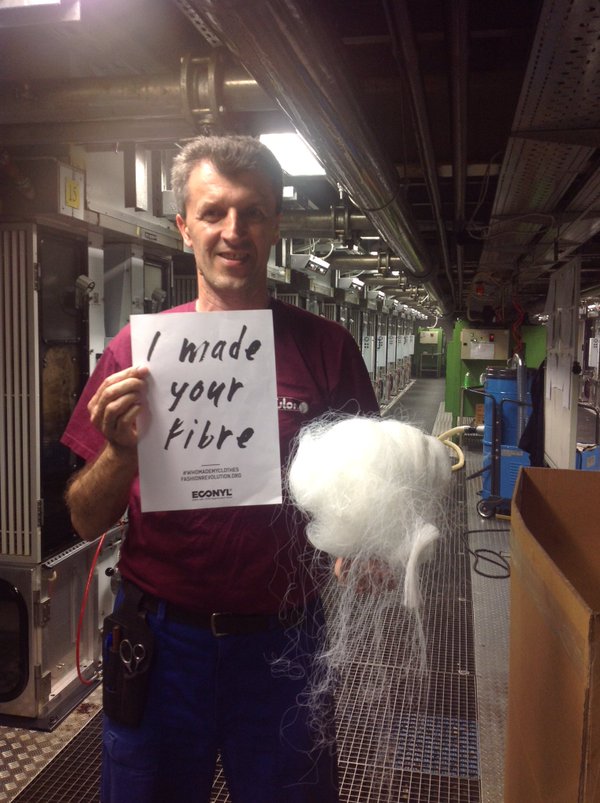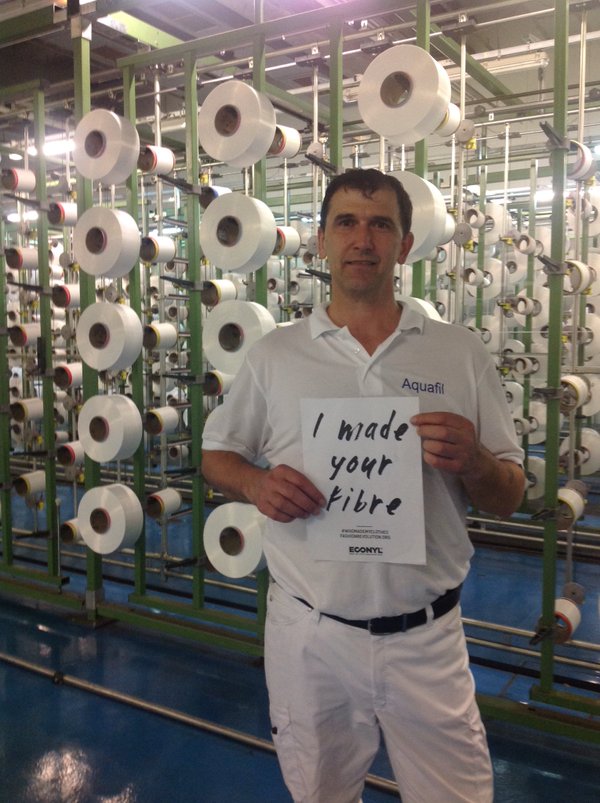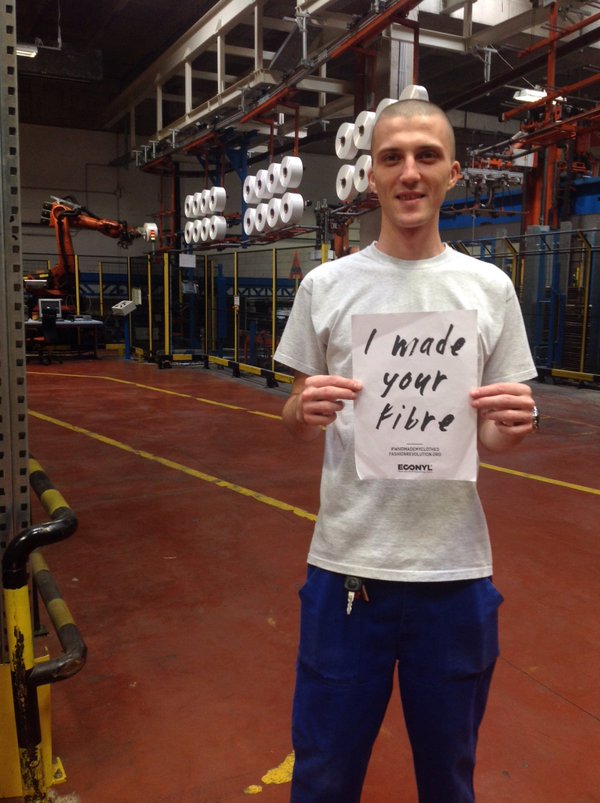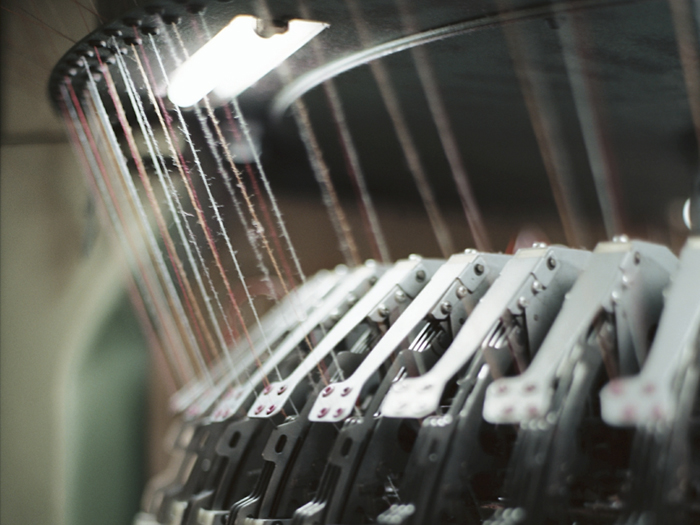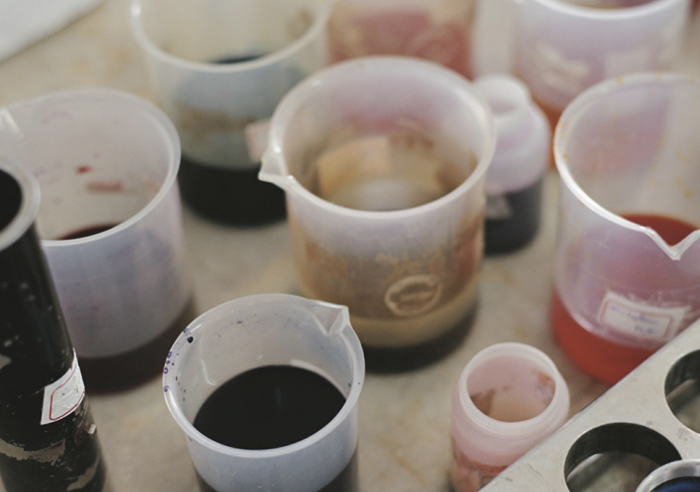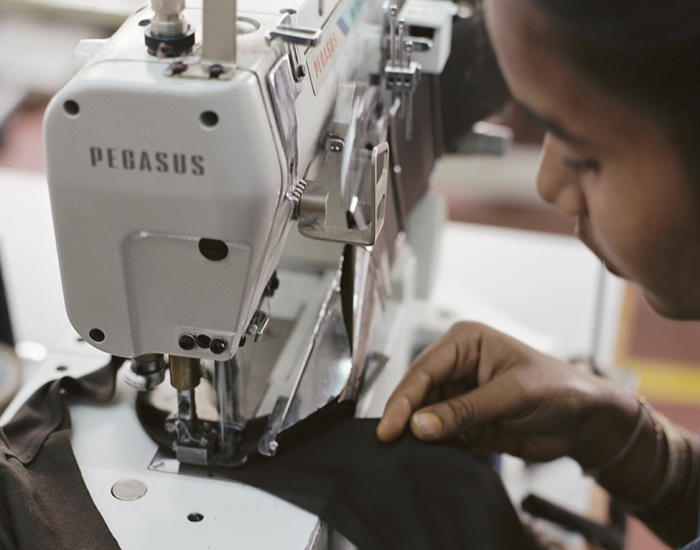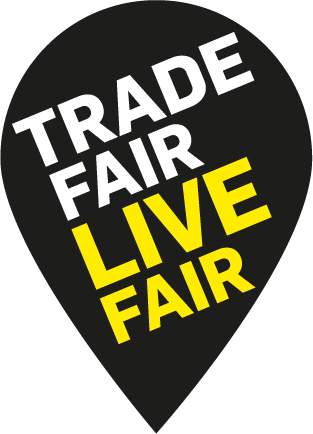During the month of February, we’ve been exploring fashion’s impact on water and looking at how we can practice water stewardship through our wardrobes. So far, we’ve discussed the consequences of industrial dyes, misconceptions around water consumption, and better laundry habits to conserve water. Now, we’re taking a look at how our wardrobes affect our oceans when they release microfibres.
What are microfibres?
Microplastics are tiny plastic pieces that are less than <5 mm in length. Textiles are the largest source of primary microplastics (specifically manufactured to be smaller than 5mm), accounting for 34.8% of global microplastic pollution [1]. Microfibres are a type of microplastic released when we wash synthetic clothing – clothing made from plastic such as polyester and acrylic. These fibres detach from our clothes during washing and go into the wastewater. The wastewater then goes to sewage treatment facilities. As the fibres are so small, many pass through filtration processes and make their way into our rivers and seas.
Around 50% of our clothing is made from plastic [2] and up to 700,000 fibres can come off our synthetic clothes in a typical wash [3]. As a result, if the fashion industry continues as it is, between the years 2015 and 2050, 22 million tonnes of microfibres will enter our oceans [4].
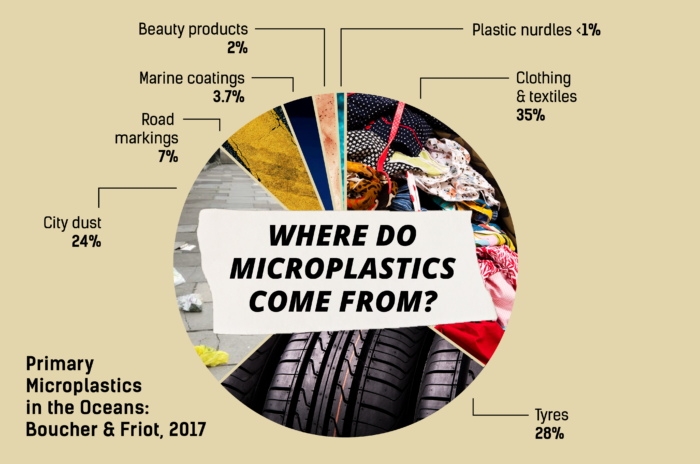
What impact do microfibres have on the environment and on human health?
Due to the tiny size of microplastics, they can be ingested by marine animals which can have catastrophic effects on the species and the entire marine ecosystem.
Microfibres can absorb chemicals present in the water or sewage sludge, such as polychlorinated biphenyls (PCBs) and carcinogenic Persistent Organic Pollutants (PoPs). They can also contain chemical additives, from the manufacturing phase of the materials, such as plasticisers (a substance added to improve plasticity and flexibility of a material), flame retardants and antimicrobial agents (a chemical that kills or stops the growth of microorganisms like bacteria). These chemicals can leach from the plastic into the oceans or even go straight into the bloodstream of animals that ingest the microfibres. Once ingested, microfibres can cause gut blockage, physical injury, changes to oxygen levels in cells in the body, altered feeding behaviour and reduced energy levels, which impacts growth and reproduction [5][6]. Due to this, the balance of whole ecosystems can be affected, with the impacts travelling up the food chain and sometimes making their way into the food we eat! It has been suggested that people that eat European bivalves (such as mussels, clams and oysters) can ingest over 11,000 microplastic particles per year [7].
What can fashion brands do?
The fashion industry needs to take responsibility for minimising future microfibre releases. Brands can have the most impact if they take microfibre release into consideration at the design and manufacturing stages. Designers should consider several criteria in order to minimise the environmental impact of a synthetic garment [3]:
- Use textiles which have been tested to ensure minimal release of synthetic microfibres into the environment.
- Ensure the product is durable so it remains out of landfill as long as possible
- Consider how the garment and textile waste could be recycled, to achieve a circular system.
During manufacture, there are several methods that can be applied to reduce microfibre shedding such as brushing the material, using laser and ultrasound cutting [4], coatings and pre-washing garments [1]. The length of the yarn, type of weave, and method for finishing seams may all be factors affecting shedding rates. However, much more research from brands needs to occur in order to determine best practices in reducing microfibres and create industry-wide solutions.
Waste-water treatment…
Waste-water treatment plants (where all our used water gets filtered and treated) are currently between 65-90% efficient at filtering microfibres [6]. Research and innovations into improving the efficiency of capturing microfibres in wastewater treatment plants is essential to prevent them escaping into our environment.
Washing machine filters…
Improving and developing commercial washing machine filters that can capture microfibres may allow for an additional level of filtration, whilst also educating consumers and businesses [8]. However, current filters which need to be fitted by the user, such as that developed by Wexco, are currently expensive and reportedly difficult to install. They also place a financial burden upon the consumers, rather than pressurising brands to commit to change. To tackle this, we need more industry research and legislation to ensure all new washing machines are fitted with effective filters to capture the maximum amount of microfibres possible. However, we then have the issue of what to do with the microfibres once we have caught them – an area which requires more research and industry collaboration.
Collaboration is key
Collaboration across multiple industries is required if we are to tackle microfibre pollution. In addition to material research, waste management and washing machine research and development, there is a role for other sectors such as detergent manufacturers and the recycling industry to come together to help reduce microfibre pollution. Cross-industrial agreements could help promote collaboration between industry bodies and promote sharing of resources and knowledge.
A major issue has been a lack of a standardised measure of measuring microfibre release. However, a cross-industry group, The Microfibre Consortium recently announced the first microfibre test method. The launch will enable its members (including brands, detergent manufacturers and research bodies) to accelerate research that leads to product development change and a reduction in microfibre shedding in the fashion, sport, outdoor and home textiles industries. The Microfibre Consortium also works to develop practical solutions for the textile industry to minimise microfibre release to the environment from textile manufacturing and product life cycles.
The need for microfibre legislation
Comprehensive legislative action is needed to send a strong message and force the brands to address microfibre releases from their textiles. This is a complicated issue that will require policymakers to tackle this issue on many different levels and sectors. Currently, there are no EU regulations that address microfibre release by textiles, nor are they included in the Water Framework Directive.
However, there have been several developments in microfibre legislation in the past few years:
- As of February 2020, Brune Poirson, French Secretary of State for the Ecological and Inclusive Transition, is the first politician in the world to pass microfibre legislation. As of January 2025, all new washing machines in France will have to include a filter to stop synthetic clothes from polluting our waterways. This makes France the first country in the world to take legislative steps in the fight against plastic microfibre pollution. The measure is included in the anti-waste law for a circular economy.
- In 2018, US states of California and Connecticut proposed legislation which would see polyester garments legally required to bear warning labels regarding their potential to shed microfibres during domestic washing cycles. However, this legislation is yet to be passed.
- In 2019, the EAC urged the UK government to accelerate research into the relative environmental performance of different materials, particularly with respect to measures to reduce microfibre pollution, as part of an Extended Producer Responsibility scheme. However, the UK government rejected the proposal stating that current voluntary measures are sufficient.
What can you do?
Write to your policymaker
It is vital that policy is put into place to tackle microfibres, such as the new French washing machine filter legislation. If you are concerned about microfibres, we encourage you to write to your policy representative and urge your government to take action on microfibre pollution. Now that France has enacted the microfibre legislation, it raises the bar for other governments to also take action, but they will only do so with enough pressure from the people they represent – you!
Changing your washing practices
The easiest thing you can do to minimise microfibres releasing from your clothing is to simply wash your clothes less. Given that up to 700,000 microfibres can detach in a single wash [3] ask yourself if that item really needs to be washed or can it be worn once or twice more before you do?
While some research suggested using a liquid detergent, lower washing machine temperatures, gentler washing machine settings [3] and using a front-loading washing machine [9] can reduce microfibre shedding. Researcher Imogen Napper stated they found that there was no clear evidence suggesting that changing the washing conditions gave any meaningful effect in reducing microfibre release.
You can also use a Cora Ball, a guppy bag or a self-installed washing machine filter to capture microfibres from your clothing. The CoraBall and Lint LUV-R (an install yourself washing machine filter) have been shown to reduce the number of microfibres in wastewater by an average of 26% and 87%, respectively [10]. Although these can’t solve the problem, we still want to divert as many microplastics as we can from entering our waterways.
Should we all switch from synthetic fibres?
While many people’s first instinct is to switch from synthetic materials to natural materials to minimise microfibre release, this is not always a simple choice as there are other sustainability aspects involved. The UK’s Environmental Audit Committee in their report states ‘A kneejerk switch from synthetic to natural fibres in response to the problem of ocean microfibre pollution would result in greater pressures on land and water use – given current consumption rates’ [11].
Demand brands to do more to take action on microfibres
“Ultimate responsibility for stopping this pollution, however, must lie with the companies making the products that are shedding the fibres.” states the Environmental Audit Committee [11], but there are still too many major fashion brands not taking responsibility for what happens in their supply chains and in the life cycle of their products. As well as demanding action from your policymaker, we should also ask brands what they are doing to minimize the microfibre release from their products. It is clear that there is still a lot of work to do, and as their customers, we have a lot of power in influencing the impacts of the brands we buy.
The impacts of microfibres on the environment can be mitigated, but only with systematic and meaningful change supported by policymakers, brands, industry, NGOs and citizens all working together.
References
[1] Boucher, J. and Friot, D. (2017). Primary Microplastics in the Oceans: A Global Evaluation of Sources. IUCN. Available at: https://portals.iucn.org/library/sites/library/files/documents/2017-002-En.pdf
[2] Textile Exchange (2019). Preferred Fiber and Material Market Report. Available at: https://store.textileexchange.org/wp-content/uploads/woocommerce_uploads/2019/11/Textile-Exchange_Preferred-Fiber-Material-Market-Report_2019.pdf
[3] Napper, I. and Thompson, R. (2016). Release of synthetic microplastic plastic fibres from domestic washing machines: Effects of fabric type and washing conditions. Marine Pollution Bulletin. Available at: https://www.sciencedirect.com/science/article/pii/S0025326X16307639?via%3Dihub
[4] Ellen MacArthur Foundation (2017). A new textiles economy: Redesigning fashion’s future. Available at: https://www.ellenmacarthurfoundation.org/assets/downloads/publications/A-New-Textiles-Economy_Full-Report_Updated_1-12-17.pdf
[5] Koelmans, A., Bakir, A., Burton, G. and Janssen, C. (2016). Microplastic as a Vector for Chemicals in the Aquatic Environment: Critical Review and Model-Supported Reinterpretation of Empirical Studies. Environmental Science & Technology. Available at: https://pubs.acs.org/doi/abs/10.1021/acs.est.5b06069
[6] Henry, B., Laitala, K. and Grimstad Klepp, I. (2018). Microplastic pollution from textiles: A literature review. Consumption Research Norway SIFO. Available at: https://www.hioa.no/eng/About-HiOA/Centre-for-Welfare-and-Labour-Research/SIFO/Publications-from-SIFO/Microplastic-pollution-from-textiles-A-literature-review
[7] Van Cauwenberghe, L. and Janssen, C. (2014). Microplastics in bivalves cultured for human consumption. Environmental Pollution. Available at: https://www.sciencedirect.com/science/article/pii/S0269749114002425
[8] Browne, M., Crump, P., Niven, S., Teuten, E., Tonkin, A., Galloway, T. and Thompson, R. (2011). Accumulation of Microplastic on Shorelines Worldwide: Sources and Sinks. Environmental Science & Technology. Available at: https://pubs.acs.org/doi/abs/10.1021/es201811s
[9] Hartline, N., Bruce, N., Karba, S., Ruff, E., Sonar, S. and Holden, P. (2016). Microfiber Masses Recovered from Conventional Machine Washing of New or Aged Garments. Environmental Science & Technology. Available at: https://pubs.acs.org/doi/abs/10.1021/acs.est.6b03045
[10] McIlwraith, H., Lin, J., Erdle, L., Mallos, N., Diamond, M. and Rochman, C. (2019). Capturing microfibers – marketed technologies reduce microfiber emissions from washing machines. Marine Pollution Bulletin. Available at: https://doi.org/10.1016/j.marpolbul.2018.12.012
[11] Environmental Audit Committee (2019). Fixing Fashion: clothing consumption and sustainability. House of Commons. Available at: https://publications.parliament.uk/pa/cm201719/cmselect/cmenvaud/1952/1952.pdf
Research and writing by Sienna Somers, Policy and Research Co-ordinator at Fashion Revolution
This month’s Power of Influence takes us in a bit of a different direction. On a 15 minute walk from London Euston to London Kings Cross, Fashion Revolution co-founder Orsola de Castro and renowned fashion critic and columnist Sarah Mower spoke with Sara Arnold of Extinction Rebellion (and Higher Studio) about the recent protests, the aim of the movement and the next steps in their fight for climate justice. Shortly after this interview, the UK Parliament declared a climate change emergency.
A little bit of context: On Saturday April 27th, during Fashion Revolution Week and towards the end of Extinction Rebellion’s 2 week occupation of Central London, Slow Factory hosted “Study Hall: Sustainability as a Culture”. The event (in its first international edition) was held in London, UK. Before the event, the Fashion Revolution team along with Sara Arnold, Sarah Mower, speakers, attendees and supporters took a walk to discuss the current happenings.
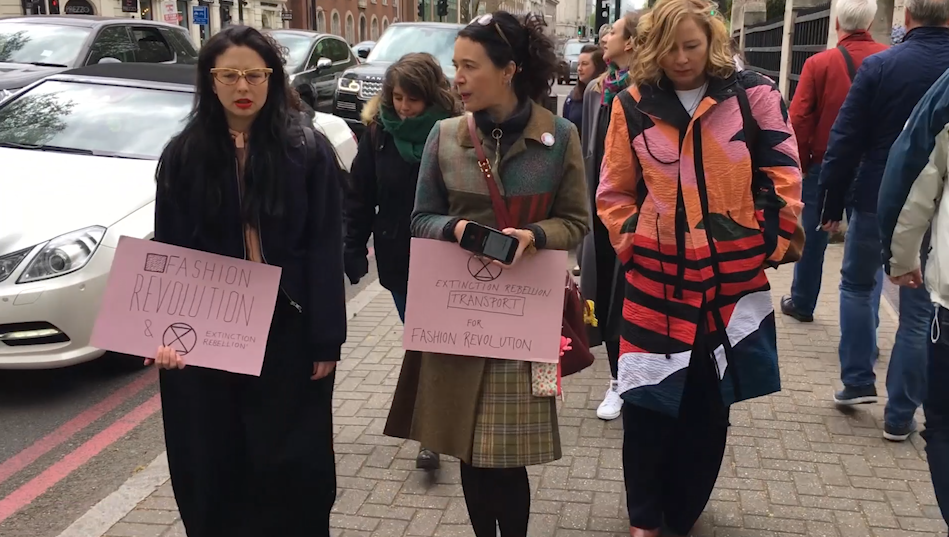
Here’s what was said:
Orsola de Castro: So the response to the protests… people are really prepared to put themselves out there. There were over 1000 arrests you say. Did you find that the overall response was positive?
SA: There has been criticism of the tactics used, there has been criticism of disruption, but that’s not we’re worried about. We want people to hear our demands, that’s what people should be focused on. I think we are making progress on that. Everyone is talking about climate change in a different way. Talking about it as an emergency. It doesn’t matter if they don’t agree with how we’ve gone about doing things. As long as it works.
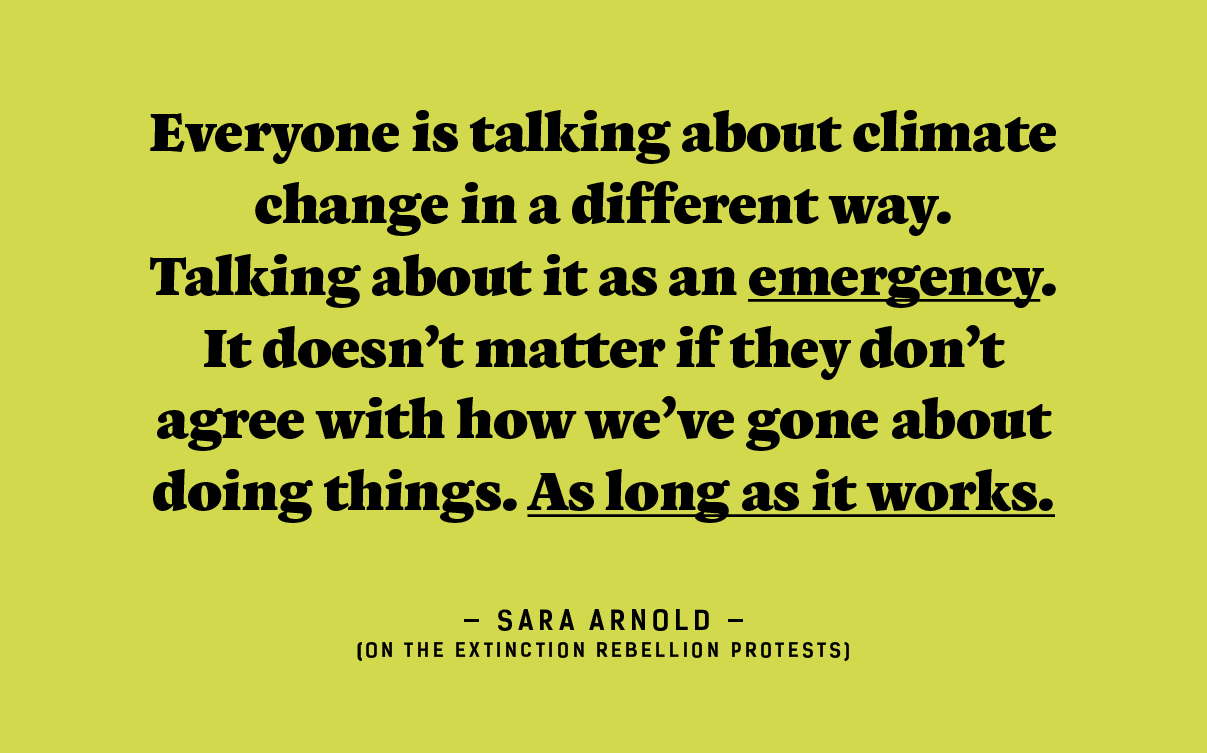
OdC: I’ve found that one of the reasons why we (Fashion Revolution) wanted to do this is the symbolism of joining hands. Even if everyone has a different way of doing things. The fact that the message is one of urgency is what we want to show. We need to all join together.
Could you tell me a little about how you guys started?
SA: Yes, so Extinction Rebellion were a group called Rising Up which started, in 2016, as a group of activists who wanted to theorise how they would go about creating this social change that we needed. They researched and put into practice different tactics. A member of Extinction Rebellion, Roger Hallam, who is currently doing his PhD at King’s College on these issues, one of the things he did was engage with an activist group at King’s that for years had been trying to get the University to disinvest from fossil fuel. They decided to stage a hunger strike. They were told that this process, even just the bureaucracy of disinvesting from fossil fuels would take a year to sort out. They said ‘okay, so let’s just try it’. So they went on hunger strike.
Sarah Mower: Because the university was investing in fossil fuels?
SA: Exactly. The whole process, from start to finish, from them going on hunger strike to all the investment coming out was 2 weeks. When they were told it would take years. So it just goes to show that direct action makes change. People do what they think is not possible when they are faced with disaster.
OdC: When I went to the first extinction rebellion meeting, you were talking about in war and in emergency, people make things happen. So the factories go from producing kitchenware to producing arms. When it is a state of emergency, historically, we’ve known citizens and organisations to take action pretty rapidly.
SA: Exactly. Now we have to get this declaration through to them so they can act.
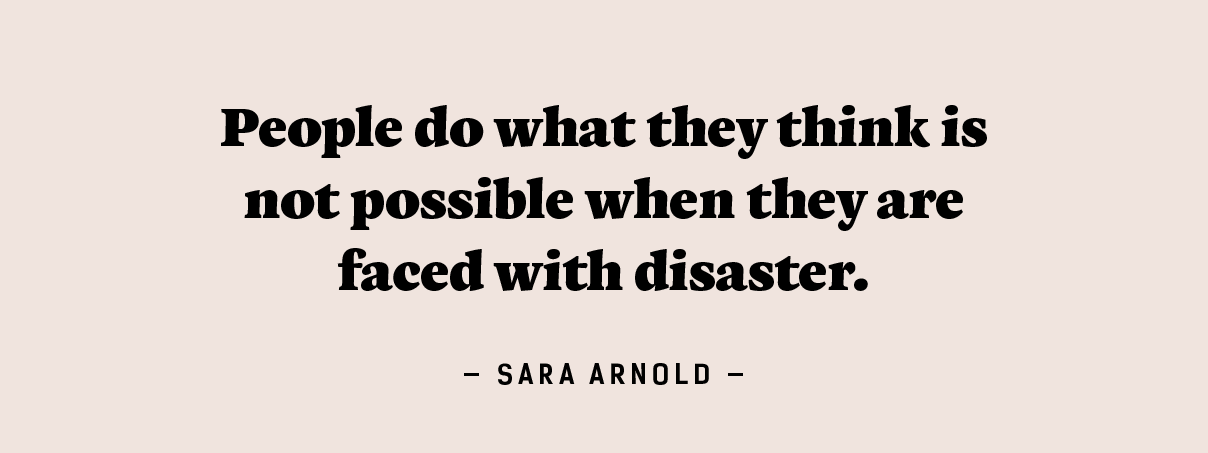
OdC: And so what about the involvement of Greta (Thunberg)?
SA: Greta was there when we held the Declaration of Rebellion on the 31st of October 2018. So we’ve had her support since the beginning. It’s really great that she came back at this time for the protests.
SM: She has changed everything.
OdC: She has changed everything.
OdC: You have other hubs in other countries, do you find there are other meaningful partnerships with local organisations in the rest of the world? Are you finding that people want to join you or do you find that they are hesitant to do so?
SA: The International Rebellion was in 33 countries. We have groups set up in 49 countries.
OdC: So like Fashion Revolution, you are de-centralised in the sense that it is volunteer run and people start their own groups.
SA: Yes. So we have 200 groups in the UK alone. The groups outside of the UK can have different demands to ours. They can adapt what we have done to respond to their own political situation. We’re so fortunate here to have police that are peaceful. And we have to use that privilege. We have a really engaged group in Ghana but if they did the same thing we are doing, they are looking at being arrested and then disappearing. It’s important for us to have solidarity with them. We keep a list of the names of those people so if anything does happen, we can protect them. It really interesting to get into that and see how we can help to take it further, internationally.
OdC: There are issues when you are a global group and you are dealing with law in different countries, even though the message is the same. Its important to recognise that.
OdC: How do you deal with citizens apathy out of fear? That people are so scared over what will happen, that they tend to go home and not know where to start.
SA: We need to really bring about this sense of urgency. That this is an absolute emergency. I feel its important to make people understand what the consequences are. We are talking about mass starvation, the death of billions of people if we reach a certain tipping point. Starvation is something we are really heading towards. We have 30 to 40 years left of fertile soil in this country, other countries are already hitting that. Let alone all the other problems. We are so dangerously close to hitting the tipping point.
Everyone is going to react to this differently. Everyone will go through a process of grief. And for a lot of people, grief will mean denial. That’s fine, you just have to feel compassion towards that. With extinction rebellion, what we are saying, is that when you give people the truth, a certain percent of the population, we think between 1 and 3% will rise up. And that is all we are aiming for. We need that 1 to 3% to rise up, to bring this to the governments and to take control.
OdC: And speak truth to power.
SA: Yes. We’ve been trying for the last 30 years to give people this positive message that we hope people will engage with and that great, but we don’t have time for that now.
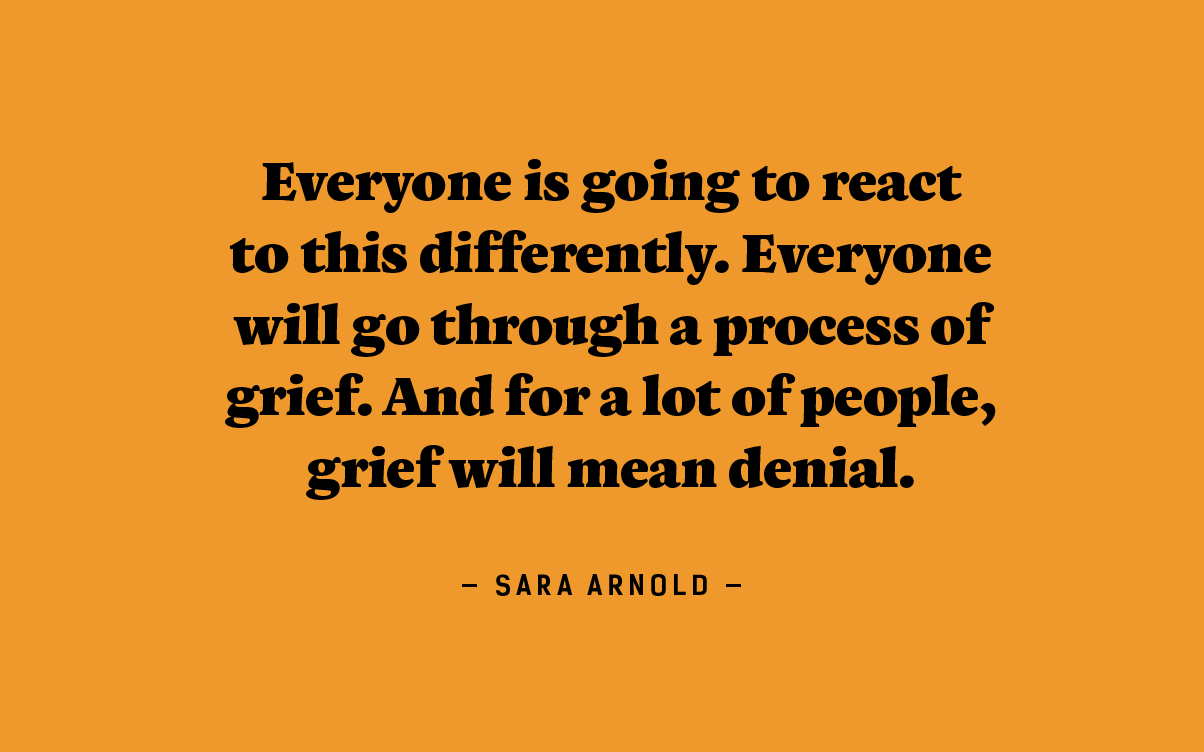
SM: So what do you think when Greta Thunberg stands in front of Michael Gove and he acts all Mea culpa. How do we hold him to account and get through real change?
SA: It’s a difficult question.
SM: If we’re talking about footfalls and governmental change.
SA: This is stage 1 of the rebellion. We can rise up and be bigger next time if we need to. I think. As we are doing that, we are waking people up to this emergency and its not something you can turn the clock back on. I think sooner or later the government will have to act.
OdC: I thought Mary Creagh was very honest at the recent Fashion Question Time when she was saying that we cannot do 2025 but working towards 2050, hoping it will gradually get faster and easier.
‘We aren’t going to get to net zero by 2025. The science will tell us what to do to get to net zero by 2050, and then in five years’ time to 2040 and then we’ll aim to get there for 2035. We have wasted the last 10 years, we’ve had no new policy in this country to change behaviour and we’ve done some policy mistakes along the way.’ Mary Creagh, Fashion Question Time at the V&A
SA: I think that we have to hit 2025. The Arctic is melting. We could lose it in a few years. That could be the tipping point that takes us into oblivion. We have to set our targets at something that seems impossible because then we are forced to look at system change. It is not about what we can do within the existing system, we have to look beyond that and listen to the science.
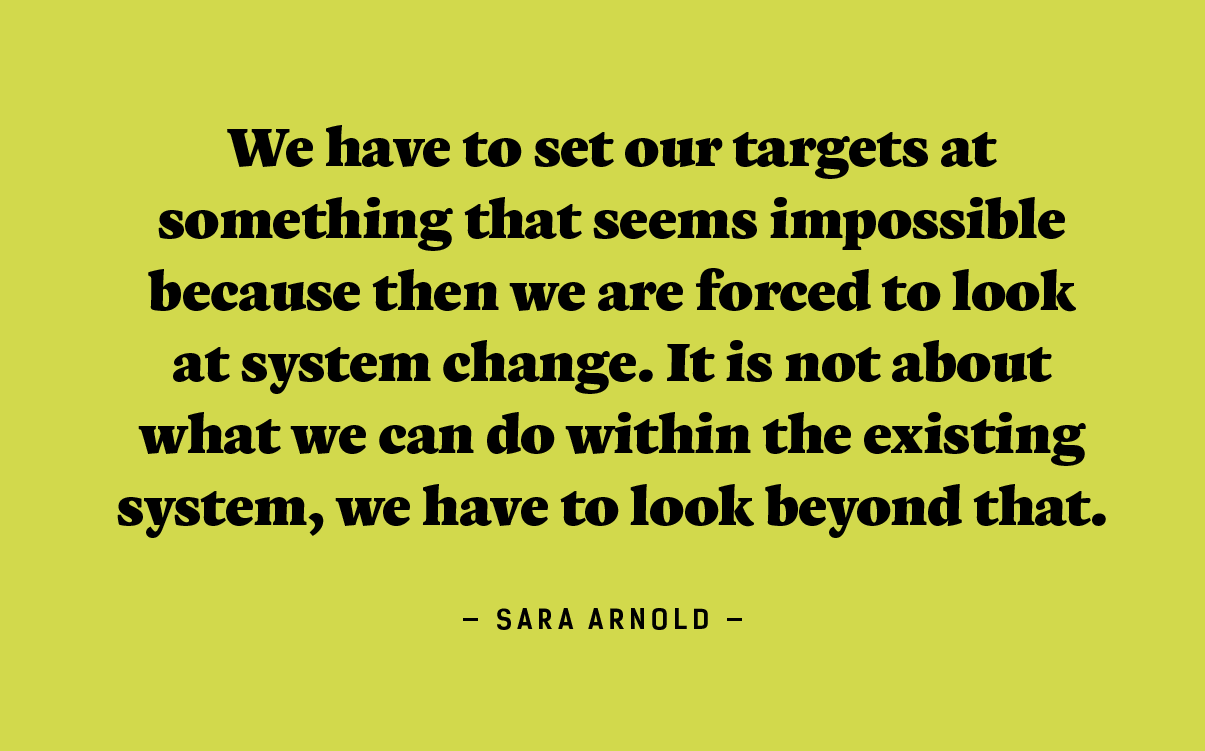
OdC: The science…the science corroborates that if we did stop now, it would get worse before it gets better.
SA: That’s the thing, pollution is currently cooling the earth. We are now 1.1 degrees warmer than we were during pre-industrial times. We need to keep ourselves below 1.5 if we are to avoid the most catastrophic consequences. BUT..If we slam on the brakes right now, the pollution will clear, causing an abrupt rise in temperature. This increase has been predicted to be between 0.5 and 1.1 degrees and so we may well have already used the carbon budget associated with 1.5 degrees of global heating. And that also puts us dangerously close to tipping points that will lead us into a so called ‘hot-house earth pathway’ of runaway climate breakdown. Its predicted that we reach this tipping point at around 2 degrees of global heating. Prof. Jem Bendell released a paper, ‘Deep Adaptation’, that puts together all the science to conclude where it is we are headed. His conclusion is that the collapse of civilisation is soon and inevitable. That immense catastrophe is likely and extinction possible.
‘I have chosen to interpret the information as indicating inevitable collapse, probable catastrophe and possible extinction.’ – Prof. Jem Bendell, Deep Adaptation: A Map for Navigating Climate Tragedy
So that is why we have to think about how we are going to adapt our culture, how we can reconnect with the thought of what it means to have a fulfilled life. What is important to us? This is why we say it’s not really about providing hope to people its saying we just need the courage to get through this and do what is necessary.
OdC: If we look at precedence, historically, the last time there was a massive mobilisation was in the 60’s. I often joke that the peace sign embroidered on jeans practically stopped the Vietnam war but it essentially sparked consumerism.
SM: Its true and now that generation, who are now grandparents, see their grandchildren protesting against it. It’s something I find very moving.
Further reading:
BBC: UK Parliament declares climate change emergency
Fashion Revolution Blog: Fashion Question Time at the V&A
The Guardian: Human society under urgent threat from loss of Earth’s natural life
Open Democracy: Britain just declared a climate emergency. What happens next?
IPCC: Special Report: Global Warming of 1.5 ºC
Life Worth: Deep Adaptation: A Map for Navigating Climate Tragedy
The Library: Study Hall: London Central Saint Martins
Check back every month for more in the Power of Influence series. We’ll post a new entry on the last day of each month throughout 2019. If you think there is someone we should be talking to, drop us a line on instagram.
We host Fashion Revolution Week in April of every year. This year kicked off on the 22nd of April. Throughout the week we encouraged people to ask brands ‘who made my clothes’ in hopes of shining a light on the unknowns of the fashion industry. By doing this, we hope to shift the focus from consumers to brands, and to all the hands involved, be it producers, workers, farmers or otherwise. We track the reach and impact of collaborators throughout Fashion Revolution Week and use the findings to fight for change worldwide, through government and policy. We are able to do this through the generous support of people like you. Please consider donating. Thank you.
WHY SHOULD BRANDS PUBLISH SUPPLIER LISTS?
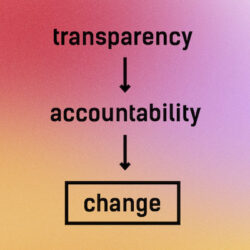
Publicly disclosed supplier lists are helping trade unions and workers rights organisations to address and fix problems which workers are facing in the factories that supply major brands and retailers. This sort of transparency makes it easier for the relevant parties to understand what went wrong, who is responsible and how to fix it. It also helps consumers better understand #whomademyclothes.
“Knowing the names of major buyers from factories gives workers and their unions a stronger leverage, crucial for a timely solution when resolving conflicts, whether it be refusal to recognise the union, or unlawful sackings for demanding their rights. It also provides the possibility to create a link from the worker back to the customer and possibly media to bring attention to their issues.” says Jenny Holdcroft, the Assistant General Secretary of IndustriALL Global Union
HAVE WE SEEN AN INCREASE IN BRANDS PUBLISHING SUPPLIER LISTS?
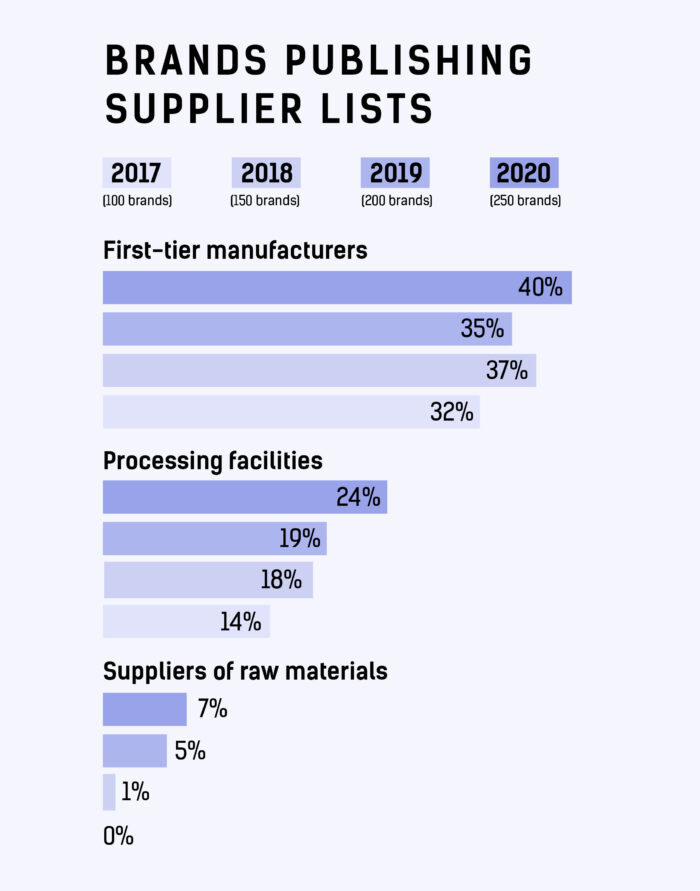
Since we began the Fashion Transparency Index in 2016, we have seen a significant increase in the number of brands publishing their first tier, processing and raw materials suppliers. In our 2020 edition of the Fashion Transparency Index, 101 out of 250 brands (40%) are publishing their first-tier manufacturers, up from 35% in 2019. These are the facilities that do the cutting, sewing and finishing of garments in the final stages of production.
60 out of 250 brands (24%) are publishing some of their processing facilities, up from 19% in 2019. These are the sorts of facilities that do ginning and spinning of yarn, knitting and weaving of fabrics, dyeing and wet processing, leather tanneries, embroidering and embellishing, fabric finishing, dyeing and printing and laundering.
And, 18 out of 250 brands (7%) are publishing some of their raw material suppliers, up from 5% in 2019. These suppliers are those that provide brands and their manufacturers further down the chain with raw materials such as cotton, wool, viscose, hides, rubber and metals.
HOW MANY BRANDS ARE NOW PUBLISHING SUPPLIER LISTS?
We have looked at large brands (over £36 million annual turnover) beyond the Fashion Transparency Index to count the number that are publishing lists of their suppliers. Below, you will find a list of over 200 brands that are publishing their first-tier manufacturers, 60 brands that are publishing their processing facilities and 21 brands that are publishing their raw material suppliers.
We are always pushing brands to provide more information about the people who make their clothes, and you can encourage them to do so too. Always ask the brands you buy #WhoMadeMyClothes. You can do this by tagging your favourite brands on social media and using this hashtag, or you can use our automated email tool to get in touch with them directly.
Brands who publish first-tier supplier lists
First-tier/ Tier One/ manufacturing suppliers are those which have a direct relationship with buyer e.g. production units, Cut Make Trim (CMT) facilities, garment sewing, garment finishing, full package production and packaging and storage.
& Other Stories (H&M group)
Abercrombie & Fitch
Adidas
ALDI-Nord
ALDI SOUTH
Amazon
Ann Taylor
Anthropologie (URBN)
ARROW (PVH)
ASICS
Aldi North
ASOS
Athleta (GAP Inc.)
Autograph (Speciality Fashion Group)
Banana Republic (GAP Inc.)
Berghaus (Pentland Brands)
Berlei (Hanes)
BESTSELLER
BigW (Woolsworth Group)
Black Pepper (PAS Group)
Boden
Bon Prix
Bonds (Hanes)
Boxfresh (Pentland Brands)
Brand Collective
Brooks Sports
Burton (Arcadia)
C&A
Calvin Klein (PVH)
Champion (Hanes)
Cheap Monday (H&M group)
City Chic (Speciality Fashion Group)
Clarks
Cole’s (Wesfarmers Group)
Columbia Sportswear Co.
Converse (NIKE, Inc)
Cos (H&M group)
Cotton:On
Crossroads (Speciality Fashion Group)
Curvation (Fruit of the Loom, Inc.)
David Jones
Debenhams
Designworks (PAS Group)
Disney
Dorothy Perkins (Arcadia)
Dressmann (Varner)
Eagle Creek (VF Corporation)
Eastpak (VF Corporation)
Eileen Fisher
El Corte Inglés
Ellesse (Pentland Brands)
Esprit
Evans (Arcadia)
Factorie (Cotton On Group)
Fanatics
Fjällräven
Forever New
Free People (URBN)
Fruit of the Loom
G-Star
Galeria Inno (HBC)
Galeria Kaufhof (HBC)
Gap
George at Asda (Walmart)
Gildan
H&M
Hanes
Helly Hansen
HEMA
Hermès
Holeproof Explorer (Hanes)
Hollister Co. (Abercrombie and Fitch Co.)
Hudson’s Bay Company (HBC)
HUGO BOSS
Hurley (NIKE, Inc)
Intermix (GAP Inc.)
IZOD (PVH)
JACK&JONES (BESTSELLER)
Jack Wolfskin
Jacqueline de Yong (BESTSELLER)
JAG (APG & Co)
Jansport (VF Corporation)
Jeanswest
JETS Swimwear (PAS Group)
Jockey (Hanes)
John Lewis
Joe Fresh (Loblaw Companies Limited)
Jordan (NIKE, Inc)
Junarose (BESTSELLER)
KangaROOS (Pentland Brands)
Kathmandu
Katies (Speciality Fashion Group)
Kaufland
Kayser (Hanes)
Kipling (VF Corporation)
Kmart Australia (Wesfarmers Group)
Lacoste
Lee (VF Corporation)
Levi Strauss & Co.
Lidl
Lindex
Littlewoods (Shop Direct)
Loblaw
Loft (Ascena)
Lord & Taylor (HBC)
lucy (VF Corporation)
Lululemon
Majestic (VF Corporation)
Mamalicious (BESTSELLER)
Mammut
Marco Polo (PAS Group)
Marimekko
Marks & Spencer
Matalan
MEC
Millers (Speciality Fashion Group)
Missguided
Miss Selfridge (Arcadia)
Mizuno
Monki (H&M group)
Monsoon
Morrisons (Nutmeg)
Name It (BESTSELLER)
Napapijiri (VF Corporation)
Nautica (VF Corporation)
New Balance
New Look
Next
Nike
Noisy May (BESTSELLER)
Nudie Jeans
Old Navy (GAP Inc.)
Only (BESTSELLER)
Only & Sons (BESTSELLER)
Outerknown (Kering Group)
Outfit (Arcadia)
OVS
Patagonia
Pieces (BESTSELLER)
Pimkie
Playtex (Hanes)
Primark
Prisma (S Group)
Puma
R.M Williams
Razzamatazz (Hanes)
Red or Dead (Pentland Brands)
Reebok (Adidas Group)
Reef (VF Corporation)
REI Co-op
Review (PAS Group)
Rider’s by Lee (VF Corporation)
Rio (Hanes)
River Island
Rivers (Speciality Fashion Group)
Rock & Republic (VF Corporation)
rubi (Cotton On Group)
Russell Athletic (Fruit of the Loom, Inc.)
Sainsbury’s – Tu Clothing
Saba (APG & Co.)
Sak’s Fifth Avenue (HBC)
Selected (BESTSELLER)
Sheer Relief (Hanes)
Sisley (Benetton Group)
Smartwool (VF Corporation)
SPALDING (Fruit of the Loom, Inc.)
Speedo (Pentland Brands)
Sportscraft (APG & Co.)
Supré (Cotton On Group)
Target
Target Australia (Wesfarmers Group)
Tchibo
Ted Baker
Tesco
The North Face (VF Corporation)
The Warehouse
Timberland (VF Corporation)
Tod’s
Tommy Hilfiger (PVH)
Tom Tailor
Topman (Arcadia)
Topshop (Arcadia)
Under Armour
Uniqlo (Fast Retailing)
United Colours of Benetton (Benetton Group)
Urban Outfitters (URBN)
Van Heusen (PVH)
Vanity Fair Lingerie (Fruit of the Loom, Inc.)
Vans (VF Corporation)
Vassarette (Hanes)
Vero Moda (BESTSELLER)
Very (Shop Direct)
Victoria’s Secret (L Brands)
Vila Clothes (BESTSELLER)
Voodoo (Hanes)
Wallis (Arcadia)
Warner’s (PVH)
Weekday (H&M group)
White Runway (PAS Group)
Wrangler (VF Corporation)
Yarra Trail (PAS Group)
Y.A.S. (BESTSELLER)
Zalando
Zeeman
Total: 204
Brands who publish processing facilities list
Processing facilities (often referred to as facilities beyond tier 1) are involved in the production of clothing whose activities could involve ginning and spinning, knitting, weaving, dyeing and wet processing, tanneries, embroidering, printing, fabric finishing, dye-houses and laundries.
Adidas
Anthropologie (URBN)
ASICS
ASOS
Banana Republic (GAP Inc.)
Bon Prix
Burton (Arcadia)
C&A
Calvin Klein (PVH)
Champion (Hanes)
Clarks
Converse (NIKE, Inc)
Debenhams
Disney
Dressmann (Varner)
Eileen Fisher
Ermenegildo Zegna
Esprit
Free People (URBN)
Gap
Gildan
G-Star RAW
H&M
Hanes
Helly Hansen
HEMA
Hermès
Jack Wolfskin
Jordan (NIKE, Inc)
Kaufland
Levi Strauss & Co.
Lindex
Lululemon
Monsoon
New Balance
New Look
Nike (Nike, Inc.)
Nudie Jeans
Old Navy (GAP Inc.)
Patagonia
Puma
Reebok (Adidas Group)
Russell Athletic (Fruit of the Loom, Inc.)
Sainsbury’s – Tu Clothing
Target
Tchibo
Tesco
The North Face (VF Corporation)
The Warehouse
Timberland (VF Corporation)
Tommy Hilfiger (PVH)
Topman (Arcadia)
Topshop (Arcadia)
Uniqlo (Fast Retailing)
United Colours of Benetton (Benetton Group)
Urban Outfitters (URBN)
Van Heusen (PVH)
Vans (VF Corporation)
Warner’s (PVH)
Wrangler (VF Corporation)
Total: 60
Brands who publish raw materials supplier list
Raw material suppliers are those which provide the commodity for the production of clothing e.g. cotton, wool, viscose or polyester.
ASOS
Balenciaga (Kering)
Bottega Veneta (Kering)
C&A
Eileen Fisher
Ermenegildo Zegna
Esprit
Gucci (Kering)
H&M Group
Lululemon
Marks & Spencer
Morrisons (Nutmeg)
Nudie Jeans
Patagonia
SAINT LAURENT (Kering)
Tesco
The North Face (VF Corporation)
Timberland (VF Corporation)
United Colours of Benetton (Benetton Group)
Vans (VF Corporation)
Wrangler (VF Corporation)
Total: 21
Please note: We are not endorsing the brands included in this list; this is not a ‘seal of approval.’ While publishing supplier lists is a necessary step towards greater transparency and improved conditions in fashion supply chains, it does not guarantee ethical business practices. However, we hope you find this list informative and continue to ask brands #whomademyclothes.
This list is not exhaustive and only accurate as of April 2020; if you are aware of other large brands (over £36 million annual turnover) that are publishing their suppliers, please let our Policy and Research team know at transparency@
Sparked by the buzz around HRH Meghan Markle choosing to shop amongst sustainable brands (yay), we found ourselves interested in learning more about the conscious and subconscious effect of social influencers and how that can shape our buying habits. Throughout 2019, we will be sharing our ‘Power of Influence’ series, talking to people within the fashion and social media realms about how they are using their platform for positive action. In this post, we celebrate Mutha.
Mutha are my favourite new source for all things sustainability. They not only have great fashion related content but they also delve in to other areas such as food, tech, sport and feminism. Their youtube channel is hosted by an insanely engaging team of presenters and their #relatable language and design aesthetic is something to be envious of. Current faves in their playlists include ‘Zero Waste Man‘ and ‘Black Friday Madness‘. To find out more about how it all happens, I chatted to Susan Adegboye, Mutha’s social media coordinator.
[youtube v=”6XqRPsULEnk”]
What is Mutha and how did it start?
So Mutha stemmed from wanting to celebrate the individuals and organisations operating in the world of food, fashion, travel and sport that are making a conscious effort to look after this planet of ours. We wanted to create a platform dedicated to the forward thinkers that were shifting the dial for a sustainable future, highlighting the importance of looking after the planet but without the scaremonger tactics.
Can you explain a little about the kind of content Mutha is creating to bridge that gap?
We tried to bridge that gap by including communities and groups that have previously never really been involved. A good example of this is SpAir Max Day, where we decided to tap into the sneaker community.
Coinciding with Nike Air Max Day on March 26th, we filmed a two-part series with renowned sneaker head Kish Kash, encouraging the sneaker community and a few household names such as Annie Mac, Clara Amfo and Leo Greenslade, to look into their vaults and donate some of their used, worn-in and probably landfill destined kicks to launch the first ever pop up sneaker shop where customers donate instead of buy. With the aim of collecting 1000 pairs of Air Max, cleaned by the team at Jason Markk and donated to the Brixton Soup Kitchen clothing and shoe bank.
We wanted to show the Mutha audience that upcycling and donating our used clothing and shoes not only has a positive impact on the environment, but that it can help people in our community in need. We wanted to work with the sneaker community to show how they can come together to do something good.
[youtube v=”ABaUzcJk33Q”]
I think thats a really interesting point – including communities that haven’t previously been part of the conversation. At this point, it feels like there is something everyone can do to play their part.
Exactly!
One of Muthas instagram post states ‘you don’t have to be perfect, just do your best’. Do you think there is a tendency to shame when it comes to issues of sustainability?
Nobody’s perfect and we all make mistakes, we’re human after all. It’s about what we do after the mistakes that really matters.
On that note, the team of presenters on Mutha feels very natural, honest, like they are part of the communities they interact with and they are experiencing the challenges and issues at the same time the audience are. Was it a conscious decision to work in this way?
Our presenters and the rest of the Mutha team, do not want to preach, but rather learn and share to inspire positive change. They represent the team behind the scenes who create the content and more importantly the audience who watch it. Our presenters come from varied backgrounds and have passions in totally different areas, but are all connected in the quest to learn and to live in a more sustainable way.
Thats definitely something that personally resonated with me when I first came across Mutha. It’s an inviting atmosphere. You sympathise and relate to the faces and voices you see and hear. Have you seen a positive reaction to this approach? Do your audience get it? Are they realising what they can do?
Ah we’re happy to hear that! At Mutha we believe that change has to start from within, we’re all on a journey here and in the 9 months since we started it we’ve all seen changes in ourselves and in our habits. The world of sustainability is often filled with doom and gloom, but a lot of us feel more optimistic now than we did before we started this journey. All the people that we’ve featured on our channel (and most of the feedback that we’ve received from our audience) is that Mutha feels like a celebration and inspires us to take the small actions that lead to big change.
So what does the future of Mutha look like?
The future of Mutha looks bigger and better, creating a lasting impact on an even wider scale. We hope that we can continue to provide a place where people can learn about sustainability and appreciating the world that we live in.
Thanks, Susan!
To keep up to date with all things Mutha, you can follow them on instagram and subscribe to their youtube channel. The second part of their two part SpAir Max Day initiative launched April 4th – see the video here.
Check back every month for more in the Power of Influence series. We’ll post a new entry on the last day of each month throughout 2019. If you think there is someone we should be talking to, drop us a line on instagram.
We host Fashion Revolution Week in April of every year. This year kicks off on the 22nd of April. Throughout the week we encourage people to ask brands ‘who made my clothes’ in hopes of shining a light on the unknowns of the fashion industry. By doing this, we hope to shift the focus from consumers to brands, and to all the hands involved, be it producers, workers, farmers or otherwise. We track the reach and impact of collaborators throughout Fashion Revolution Week and use the findings to fight for change worldwide, through government and policy. We would hugely appreciate it if you would be willing to share a story or celebrate a brand you love or simply ask #whomademyclothes during Fashion Revolution Week in 2019.
Sparked by the buzz around HRH Megan Markle choosing to shop amongst sustainable brands (yay), we found ourselves interested in learning more about the conscious and subconscious effect of social influencers and how that can shape our buying habits. Throughout 2019, we will be sharing our ‘Power of Influence’ series, talking to people within the fashion and social media realms about how they are using their platform for positive action. In this post, we talk to Ashley AKA bestdressed.
There is something different about Ashley’s videos. There is no big agenda, no preaching or bragging, no shaming when she talks about clothes. There is just this subtle little undercurrent of care and attention in the way she approaches her wardrobe. Thrifting, flipping (making new things out of old things) and the occasional scattering of self-deprecating humour makes for some exceedingly entertaining videos. Being an avid fixer and flipper myself, I wondered what made Ashley start working in this way and what effect, if any, she thinks it has on her audience.
Could you share your name and various media handles:
Ashley (aka bestdressed)
Youtube: bestdressed
Instagram: @best.dressed
Upon first glance, your youtube channel might seem like many others – OOTDs, clothing hauls and ‘day in the life of’s. When digging in though, your approach to sustainability through thrifting, upcycling and flipping your finds is totally ingrained into everything you do and say. For us, this is such an important and positive message to be spreading, something that others on the platform can seem to ignore. What made you start working in this way? Was sustainable fashion something you’ve always been conscious of?
I’m flattered, but honestly I never made a conscious choice to be a ~hero~ of sustainability! My love of thrifting and tendency to rewear clothes really comes from a financial perspective. When I was a younger, I never liked thrifting, My sister would always find gems, but I’d get bored and frustrated 15 ugly sweaters in and go play Doodle Jump in a corner. But two summers ago, when was in full on chipmunk mode post-wisdom teeth removal, I needed something to pass the time before my cheeks deflated. Lo and behold, I decided to go thrifting, and finally found some cool stuff. From that point on, I was obsessed – mostly because at that point I was still working for $8 an hour at an ice cream shop and could use the cheapest clothes I could get. Plus, I was about a year into my (vastly unsuccessful at that point) YouTube career. I would post a haul or OOTW here and there, but I could never seem to keep up with other girls who would have five completely new outfits each week. Thrifting, for me, was a way to experiment with my style and make interesting content, and rewearing clothes for years (even “fast fashion” clothes from Forever21) was just a product of not having that much money.
In a lot of your videos you alter, adjust, flip your existing clothes (or second hand clothes) into something totally new. Do you think it’s something everyone could and should be doing? Does this satisfy the itch to own something new, without playing into the fast-fashion world?
For me, it’s even better! It’s like Marx’s theory of alienation from the work product, right? There’s something so satisfying about making or altering something yourself. Every time you look at it or wear it you get to be like “Damn! I did that! And nobody else has anything like it!” I know everyone’s not the craftiest or has time to alter their clothes, but I hope I can encourage people to at least give it a try! Something as simple as patching up a hole instead of throwing a shirt out, or cropping an old t-shirt are a great place to start!
Do you feel the pressure from brands to buy? Do you think it’s possible to stay fashionable without buying in excess?
Absolutely. That’s the whole job of the marketing industry. And now social media is overtaken by the marketing industry. So every day, tons of images and videos are telling you that you want new things. Honestly I fall victim to this too. It’s usually only when I’m bored or procrastinating or feeling shitty, but I’ll go into this fervor of opening tabs and adding items to my cart. Normally the total price at checkout stops me though, haha. I don’t go to malls anymore because they make me crazy. Literally my brain just goes: clothes! clothes! more clothes! I sound insane but I swear this probably happens to a lot of us. Luckily, a lot of what’s “fashionable,” at least for a certain segment of internet hipsters, is shifting towards thrifted and vintage clothes. I love that it’s cool now to wear an old oversize t-shirt or a vintage linen dress. Since my entire job revolves around fashion, I do still buy new clothes, but I always think about my purchases thoughtfully and try to mix in thrifted, vintage, sustainable, and altered clothes.
Do you see an uptake in responsibility from your followers when you share content that focuses on sustainable issues? Do their responses show that they’re thinking differently about what they buy and how they buy?
Honestly unfortunately I think it’s a bit of singing to the choir when it comes to sustainable vs. fast fashion. There are still crazy amounts of $300, $500, $5000 Wish/Zaful/Shein hauls online, with audiences willing to watch. I’m chillin over here in my corner of the internet with gals who already love thrifting. And who’s reading this article? Surely people who already care about sustainable fashion. Perhaps that’s just me being a bit of a pessimist. In the long run, I think sustainable content can change how people think, but it takes time. I hope that at least some people who have subscribed to my channel from a fashion video have found their way to a thrift haul, and after watching a couple, have tried thrifting on their own! And maybe my thrift flips makes fellow sewing nerds like me feel a little cooler lol.
Okay now for some quick ones…
- Current favourite piece in your closet?
A sherpa jacket I thrifted from the men’s section! So cozy and looks like it cost a fortune - Do you remember the first piece of clothing that you ever bought for yourself?
A gray American Eagle hoodie in 6th grade - Do you still have it?
I wore it nearly every day to school for 3 years (I was one of those kids) but we had to part ways after it was pretty much falling apart. - Do you know who made the clothes you are currently wearing?
My top is thrifted (so not sure who made it originally) and my jeans are Redone vintage Levi’s made in the US. - Top tip for others wishing to shop more responsibly?
Start with browsing a vintage or thrift store, finding a few quality sustainable pieces to invest in, looking through your own closet to find old gems you forgot you loved… or even remembering to return items you don’t end up loving – that’s a huge one! It’s so easy, you get your money back, and you don’t end up with clothing sitting in the back of your closet. You’d be amazed by how many people buy stuff and can’t be bothered to return it. I think sustainable culture can be a bit intimidating and make you feel guilty for your past purchases or if you aren’t perfectly sustainable at the start. It’s all about starting small – even if you just stop and think about one fast fashion purchase per month, that’s still awesome!
Thanks, Ashley 🙂
Check back every month for more in the Power of Influence series. We’ll post a new entry on the last day of each month throughout 2019. If you think there is someone we should be talking to, drop us a line on instagram.
We host Fashion Revolution Week in April of every year. This year kicks off on the 22nd of April. Throughout the week we encourage people to ask brands ‘who made my clothes’ in hopes of shining a light on the unknowns of the fashion industry. By doing this, we hope to shift the focus from consumers to brands, and to all the hands involved, be it producers, workers, farmers or otherwise. We track the reach and impact of collaborators throughout Fashion Revolution Week and use the findings to fight for change worldwide, through government and policy. We would hugely appreciate it if you would be willing to share a story or celebrate a brand you love or simply ask #whomademyclothes during Fashion Revolution Week in 2019.
Sparked by the buzz around HRH Megan Markle choosing to shop amongst sustainable brands (yay), we found ourselves interested in learning more about the conscious and subconscious effect of social influencers and how that can shape our buying habits. Throughout 2019, we will be sharing our ‘Power of Influence’ series, talking to people within the fashion and social media realms about how they are using their platform for positive action. First up is Arden Rose.

I was recommended Arden’s youtube channel by Youtube itself (thanks algorithms). Finding a funny, interesting AND socially, environmentally conscious human who also creates entertaining content is pretty rare, right? Exactly. I was hooked right away, and with 1.4 million youtube subscribers and coming up to 900k followers on instagram, I wasn’t the only one. My first point of call was watching the fantastically titled ”how to NOT destroy the planet while shopping“. There were many questions I wanted to ask, much admiration I wanted to share. So…after a quick binge of other videos, and a swift click of the subscribe button, Arden became the first in this series of interviews. Her answers didn’t disappoint. Read on, read on…
To start, could you share your name and various media handles:
@ardenrose on everything!!
In a community of hauls, where buying in excess and presenting that image to the world is commonplace, you choose to do differently. We think that’s totally awesome and also pretty brave. Was it hard for you to step away from the established way of working and suggest a different way of doing things?
It was hard in the sense that hauls tend to do well on YouTube and they’re easy (i.e. unoriginal) content to make. Honestly, buying that much junk was tiring, it filled up my closet with trendy pieces I don’t want in a month, and it was boring to make. I’m so much happier to share clothing that I had to hunt or search for to make it sustainable and worth showing on my channel! Honestly, everyone should give themselves the challenge of not relying on constantly selling their audience on cheap slave labor. Definitely helps me sleep (slightly) better at night.
Your video ‘how to NOT destroy the planet while shopping’ is SO well informed and honest and great. You mention other youtubers who inspired your choices. Do you think more people on the platform need to be addressing these issues?
ABSOLUTELY. It shocks me that people can just turn a blind eye to the obvious pain they allow corporations to get away with or ignorantly support. Everyone should be promoting sustainable business practices, especially the women on the internet that tend to to push fast fashion as a “cheap” and “easy” alternative to a constantly refreshing industry like the fashion industry. Viewers should be educated, but at the very least the entertainers who are preaching to them should be educated.
Have you always been a conscious consumer or was there a moment when the switch flipped and you started to think more about the way you buy?
I touch on this briefly in my “how to NOT destroy the planet while shopping” video, but I used to make H&M and Forever21 hauls allllll the time. Constantly. My channel was filled with that shit. Fortunately I sat down and watched all the necessary documentaries and read all of the articles late last year and completely got my stupid self educated on the issue. Honestly, I always KNEW that fast fashion was bad business, but I was wilfully ignorant so that I didn’t have to give up my shopping addiction that felt baked into my personality.
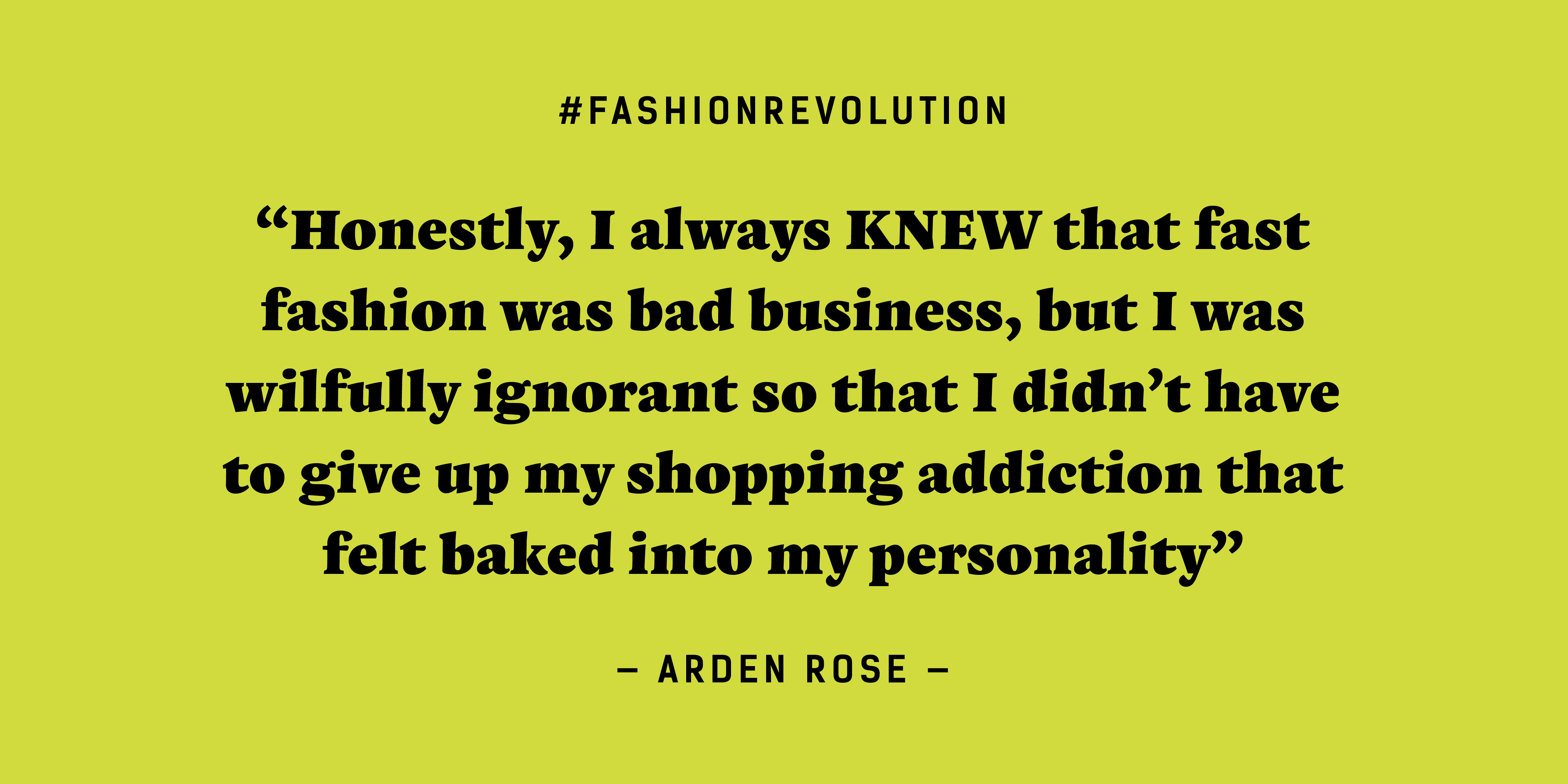
Do you see an uptake in responsibility from your followers when you share content that focuses on sustainable issues? Do their responses show that they’re thinking differently about what they buy and how they buy?
Yes!! And that’s what’s so amazing to me! I don’t even have the largest audience but I get hundreds of comments about my sustainability video a week. I didn’t even think that many people saw it! Nowadays, consumers want to be in the know, and they want clear consciences. Having a friend on the internet (me!) sitting you down and calling you out on the way you’ve been spending your money is helpful and doesn’t feel accusatory! It feels like friendly advice which is important. A lot of people get turned off of the sustainability conversation because it sounds preachy. You need to be a friend to these people, not a holier than thou asshole. I like to think I’ve helped a lot of young women and men rethink their spending habits when it comes to fashion, but I also think it’s just the power of a younger generation that actually cares about others and the planet! They’re awesome and so fired up for change!
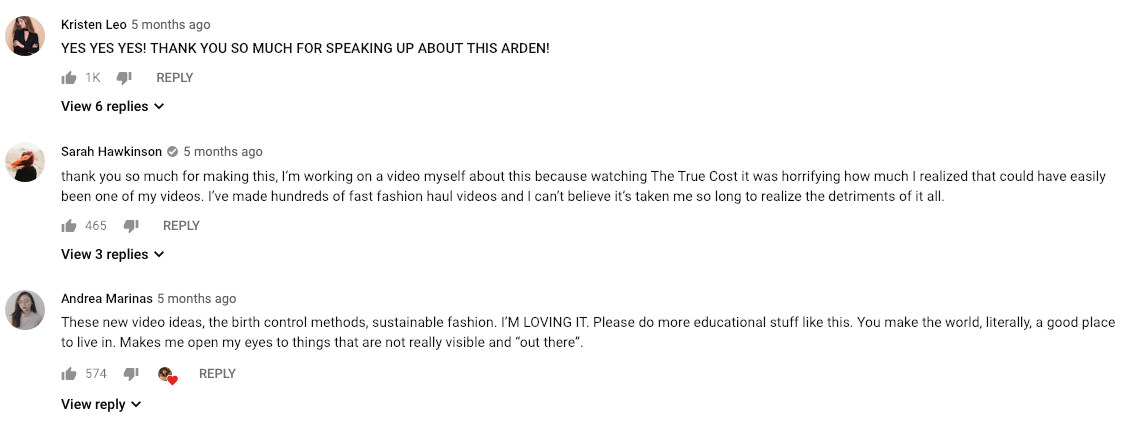
Do you think it is easy to find and share information about the sustainability of fashion brands and the effects of fast fashion on people and planet? Is there anything you can think of that would help make it easier to do so?
It is easy if you want to find it. It would be easier if large publications and fashion houses made it a priority to promote the message. It doesn’t benefit the industry to reveal its ugly underbelly, so they try to hide it, or dangle a carrot in your face via a “sustainable line” that only happens once in a blue moon. If there was a grassroots coalition of the top fashion bloggers and instagram baddies calling these companies out and only promoting sustainable brands, I can bet you big money things would shift in a major way.
Okay now for some quick ones…
- Current favourite piece in your closet?
A brown corduroy button down dress from Paloma Wool that I bought recently. - Do you remember the first piece of clothing that you ever bought for yourself?
I would have NO idea and I find that sad. It was probably a tee-shirt from Target if I’m being honest. - Do you still have it?
Definitely not. - Do you know who made the clothes you are currently wearing?
Yes! A small company in Denmark knitted my sweater, my tee shirt is of my own design and is produced sustainably in Canada, and my leggings are from an activewear company that produces everything in a mom and pop shop out of Italy. Wearing a very well traveled outfit right now hahaha. - Top tip for others wishing to shop more responsibly?
Unless a brand *explicitly* advertises that it’s sustainable, be skeptical, and even if they do, remain skeptical. Educate yourself. We have the internet now and have 0 excuses to be ignorant! If you question the sustainability of a brand, do a quick google search before committing to the purchase. It’s true that sustainable fashion tends to be a bit pricier but just think about all the hands that it took to create the piece you’re holding and the people they belong to that are being paid well and treated with respect because you’re willing to treat your closet with respect. We don’t NEED an abundance of new clothes every season, we’ve been duped by an industry that only has money in mind. You don’t have to have the latest trend in your closet, you can re-wear clothes until they fall off your body, and anyone who judges you for your lifestyle is slow on the uptake.
Thanks, Arden 🙂
Check back every month for more in the Power of Influence series. We’ll post a new entry on the last day of each month throughout 2019. If you think there is someone we should be talking to, drop us a line on instagram.
We host Fashion Revolution Week in April of every year. This year kicks off on the 22nd of April. Throughout the week we encourage people to ask brands ‘who made my clothes’ in hopes of shining a light on the unknowns of the fashion industry. By doing this, we hope to shift the focus from consumers to brands, and to all the hands involved, be it producers, workers, farmers or otherwise. We track the reach and impact of collaborators throughout Fashion Revolution Week and use the findings to fight for change worldwide, through government and policy. We would hugely appreciate it if you would be willing to share a story or celebrate a brand you love or simply ask #whomademyclothes during Fashion Revolution Week in 2019.
With the recent publicity around sustainable oriented fashion new year resolutions we’re revisiting this article centred around ASOS’s announcement to ban all feathers, silk mohair and cashmere last year. The article raises the point that whilst praise should be given to those re considering the attitude towards fashion and their wardrobes, blanket statements towards your future habits are not always the best form of action. We encourage you to think, question and research solutions to your current less favourable buying habits. Moving to sustainable fashion is step in the right direction, however the term is broad, only through research and transparency can we separate the brands genuinely looking to install good practices at every level of the supply chain from those just making a token gesture towards improving practices.
The recent announcement from ASOS that they will be banning all feathers, silk, mohair and cashmere has started a social media furore, quite rightly. Not because the ban in itself is a mistake – it shows that they are indeed taking into account their customers’ concerns in regards to animal welfare; concerns that our insatiable desire for soft, fluffy and silky materials poses a real threat to animals and their environment. The controversy arises from our suspicions that this new policy will not introduce better solutions to replace unethical, environmentally-unfriendly fabrics.
ASOS will need to replace those products with other equally soft, silky and fluffy materials and, inevitably, the fear is that the alternative will increase the production of fabrics made from plastic-based fibres such as polyester which are potentially just as bad, if not more harmful to the natural world and the animals living in it in the long run. And therein lies the contradiction: in order not to harm goats, geese, ducks and silk worms, the risk is that other forms of life, including us, will be harmed in the process. Instead of a blanket ban on these materials, should ASOS instead have focused on innovation and responsible sourcing, such as using Peace Silk or ensuring feathers are sourced under the Responsible Down Standard guidelines?
Polyester is pure plastic, it takes an estimated 1000 years to decompose. It releases microfibres which can enter the bloodstream of marine species, causing reproductive and growth issues and when ingested they cause species to think they are full and consequently become malnourished. Moreover, they can can enter human bodies when we consume shellfish, with currently unknown consequences. It has been estimated that 1.4 million trillion microfibres are currently in the oceans (Leonard, 2016), with some regions releasing up to 281 kilotonnes of primary microplastics per year (Boucher and Friot, 2017). If the fashion industry continues in a business-as-usual scenario, between 2015 and 2050 22 million tonnes of microfibres will enter our oceans (Ellen MacArthur Foundation, 2017).

The fact that polyester is recyclable in circular, closed loop systems is not an excuse because we are still far from having an industry capable of recycling its plastic successfully enough not to produce more plastic overall. We are on the road to circularity, but we are not there yet.
We are nowhere near an industry where materials are recycled or downcycled in a clean, non-toxic, efficient way. The technology to recycle mixed blends such as cotton and poly still requires further injections of polyester to increase quality and functionality and blended fabrics cannot yet be commercially separated at scale in order to recycle the different fibres.
Even biodegradable materials are not completely harmless. Organic waste decomposing in landfill is one of the biggest contributors of atmospheric methane. At the moment, we really are stuck between a rock and a hard place.
The debate over ASOS’s announcement is possible because there is now enough information on the negative effects of plastic on our environment. Not enough was done by ASOS to consider the reaction of a better educated audience and not enough reassurances were given on what alternative materials will be used instead. This announcement did look a lot like a nod to the growing animal welfare lobby, rather than a well thought out strategy leading to real and radical changes for the better. Is this a convenient excuse to divert from costly fibres and replace with synthetic alternatives in the name of ethical progress?
The announcement may prove that ASOS, like other brands, are listening but it also shows that they don’t necessarily know where they are going because right now nothing has a simple solution; almost every step comes accompanied by a fair amount of inevitable contradictions.
It won’t be easy or quick to steer these gigantic ships, to change our habits and theirs in favour of fully sustainable alternatives. Of course, the entire fashion industry needs to speed up and adopt better social and environmental practices throughout its complicated, ineffective and exploitative supply chain and what we can keep doing is encouraging debate and dialogue. Be vigilant, scrutinise, keep asking questions. This at least will show brands that we won’t be satisfied by half measures and unresolved solutions. That we expect real change because we want to wear clothes that make us feel good – and exploitation and resource depletion are definitely not a good look.
Photo credits:
Clothing sorted for recycling, Buenos Aires, Carry Somers
Ocean: Ross Miller
KnowTheChain have launched a ranking of 20 large clothing and footwear companies on their efforts to eradicate forced labor and human trafficking from their supply chains. Their Apparel & Footwear Benchmark Findings Report found only a small group of companies seriously addresses exploitation. Most companies have systems in place to monitor and react to forced labour and human trafficking, but few companies address systemic causes.
The four highest performing companies (Adidas, Gap, H&M and Lululemon) achieve scores above 60/100. Among the lowest performing companies are Hong Kong-based Belle International Holdings (0/100), Chinese clothing manufacturer Shenzhou International Group Holdings (1/100), and the luxury Italian fashion house, Prada (9/100). Across seven measurement areas, the average company score is 46 out of a possible 100. Overall, luxury brands including Hugo Boss, Kering (holding company of Alexander McQueen, Gucci, Stella McCartney and others) and Ralph Lauren score much lower than high street apparel retailers (such as H&M, Inditex or Primark), with none achieving an above average score.
This echoes the findings of Fashion Revolution’s Fashion Transparency Index, published in April 2016, where Prada, Ralph Lauren and other luxury companies received some of the lowest scores.
Longstanding public awareness and pressure, spurred from incidents of child labour in the footwear sector in the 1990s and grave health and safety incidents in Bangladeshi factories in recent years, has resulted in companies putting in place supply chain monitoring systems. However, these have a strong focus on first tier suppliers, while workers tend to be at the greatest risk further down the supply chain. Adidas, which ranked highest in the benchmark (81 out of 100 points), works in partnership with its first tier suppliers to support training for second tier suppliers and subcontractors, as well as develops models to address risks of forced labour in its third tier supply chain.
Forced labour in this sector occurs both at the raw materials level and during the manufacturing stages of apparel and footwear companies’ supply chains. The report finds that all companies benchmarked can improve in rolling out programmes that reach to all tiers of their supply chains. Companies are encouraged to promote direct hiring of workers where possible as well as to perform robust due diligence of third-party recruitment agencies. Companies are also encouraged to engage directly with supply chain workers outside the factory context, allowing companies to get a clearer picture of what is happening on the ground.
“Despite international and brand attention on worker issues for more than twenty years, many retailers haven’t addressed the deep seeded causes of worker abuse in their supply chains. Hopefully this benchmark will help them recognise that they need to do better by the people making their clothes and shoes,” said Killian Moote, director of KnowTheChain.
We can all put pressure on brands to address forced labour and other issues by asking the question #whomademyclothes as transparency is an essential first step towards improving conditions in the supply chain. Use the pledge at the bottom of Fashion Revolution’s home page to send a tweet to your favourite brand.
I was working with the Fashion Revolution team yesterday at London College of Fashion. I needed a swimsuit for my upcoming Zoology research trip to the Bahamas and heard that AURIA swimsuits were for sale at the EMG Progressive Fashion Concept Store in Beak Street, Soho, just a few blocks away. I found the perfect swimsuit! As it’s Fashion Revolution Week, I of course had to ask the question #whomademyclothes?
AURIA’s swimsuits are made from Econyl.
According to their website ‘the innovative ECONYL® Regeneration System is based on sustainable chemistry. With this process, the nylon contained in waste, such as carpets, clothing and fishing nets, is transformed back into raw material without any loss of quality.
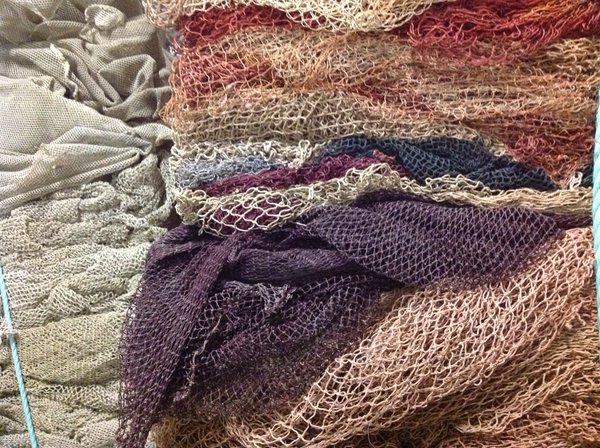
And here are the people who made my swimsuit …
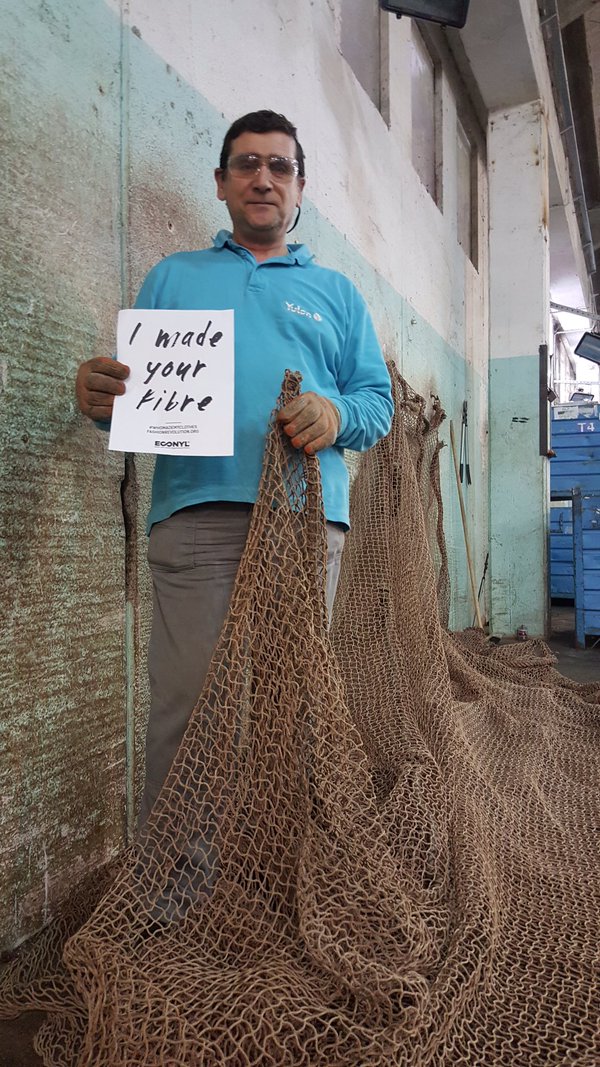
This is Paolo in the ECONYL plant He prepares nets for regeneration
This is Ivo with some nets to be turned into ECONYL yarn
Jan with some carpet fluff, the upper part of old carpets that is regenerated into ECONYL yarn
Denis & Mladen they are at the very beginning of the ECONYL regeneration process
Jozica works in the chemical lab. She checks the waste material that will become ECONYL yarn
Mirko keeps an eye on the spinning to get the best quality ECONYL regenerated yarn in Slovenia
You can always find Boro around the bobbins of ECONYL regenerated yarn to check quality
Bobbins of ECONYL regenerated yarn wouldn’t get to clients if it wasn’t for Muamer
And all of this recycled fibre then gets made into gorgeous AURIA swimsuits
I’m really happy to see that ECONYL is able to answer the question #whomademyclothes and show me the faces of everyone who has helped to make the fibre for my new swimsuit #imadeyourclothes.
The fashion industry is incredibly complex.
Fashion is a global network. From growing the cotton, weaving it into fabric, dyeing and finally sewing the garment together, each step is completed by a different group of people, in different regions and even countries. Some brands have over 500,000 different products on the market at once worldwide, thousands of factories associated with them, and millions of workers all having a hand in creating their products.
It is positive that the fashion industry is able to support the employment of so many people, in regions where opportunities can be limited. The challenge, however, is making sure that the livelihoods of these workers are protected, sometimes even above the accepted standards in that country, and that the environments in which materials are extracted and processed are not negatively impacted by these activities. Many brands have invested significant resources to evaluate and decrease these impacts, however numerous continue to struggle with achieving transparency of their supply chain in the first instance.
Why is supply chain transparency a challenge?
The strength of fashion brands is in providing consumers with finished products they want to purchase – it is not in growing cotton, mining tin, dyeing wool, or all other stages of production of fashion. Because of this, their supply chains are setup to primarily place orders directly with factories which produce their final products. Some brands do purchase key fabric or components to their products, however brands are towards the end of incredibly intricate networks of factories and workers. To achieve transparency, brands need to work backwards to identify these factories who have had a hand in producing the components used to create their products.
We lead projects with brands to uncover their supply chains. These projects are always an ongoing process of communicating the intent to suppliers. The focus is on building trust in that brands are not seeking to leapfrog over suppliers to secure better commercial deals with upstream suppliers, but rather, honest attempts at uncovering who made their clothes and how these were made. We have had some great successes in these projects, finding ways to decrease impacts quickly, connect brands to workers who they would’ve never been able to tell stories about otherwise (e.g., Mongolian goat herders), and build comprehensive pictures of their supply chains and their associated risks. In some cases, we find deceptive behaviour or suppliers being unwilling to share this information. The brands we work with then need to make a decision. Some have decided to make a stand that it is no longer acceptable to them to source from suppliers who do not share this information. Others are still trying to get this supply chain shift sold internally. However, in both cases, the important thing is that transparency is now a factor in sourcing, and is being discussed by both sustainability teams and commercial teams as the new basis for further impact reductions. Without having visibility to these suppliers, brands are unable to support impact reductions more upstream in the supply chain. Once visibility is established, we have seen impact reductions of all sizes, from investing in new machinery to simply adding nozzles to hoses to save resources.
A fundamental shift is coming
By 2050, the global population is expected to reach nine billion people – all of which will not only need clothes. Climate change has already began impacting harvests for materials like cotton worldwide, and is only expected to cause further supply disruptions in the coming years. Industrial pollution too has devastated environments, with 43% of rivers in China being unsuitable for human contact (not consumption – contact). Competition for resource is ever increasing with poor yields from harvests, and even with resources we take for granted such as the groundwater level in Bangladesh dropping by multiple metres every year, requiring factories and communities to continue drilling deeper and deeper to find water.
Legislation and international guidelines are also changing worldwide which means that companies will have full responsibility for the social and environmental impacts of their supply chain from start to finish. For some brands, this will be a catalyst for action. For others who have already invested in projects to identify and support suppliers, their first mover advantage has put them in a better position to comply with these legislations, but also have created some other potential benefits. A key high-street brand recently shared that their commitment to sourcing Better Cotton Initiative cotton for their products created a space to build trust with suppliers, get to know them better, and support them with their challenges.
Transparency as an opportunity
We must be aware that opening up an entire global industry cannot happen overnight. Instead we should celebrate some of the leaders who continually engage with their supply chains, and share with the world some of their findings (both positive and negative) and some of their stories.
Transparency will be the vehicle by which brands can identify their supply chain, engage with these suppliers and improve the environmental and social impacts associated with the production of their products. Sustainability engagement has moved far beyond a charitable exercise, it is becoming a critical business activity.
Transparency is set to be a game changer on supply chains and effective action can begin to make this a reality.
Stefanie Maurice, Principal Consultant, MADE-BY
We don’t know the true cost of the things we buy. The fashion industry supply chain is fractured and producers have become faceless. This is costing lives. Not just the mass loss of life we hear about when another disaster hits a garment factory, but the lives of individual artisans and garment workers who cannot support themselves in their own community and undertake perilous journeys in search of a better life.
Hundreds of thousands of migrant garment workers are employed throughout the fashion and textiles suppy chain, many of whom live in constant fear as they are working illegally. “They took us to the airport and left us there for three days. We couldn’t travel, because we didn’t have tickets. Armed gunmen, who we were told were from the armed forces, threatened us. We feared we would be shot if we continued to protest. We were then rounded up in a camp” reported a garment factory worker in Mauritius to the Clean Clothes Campaign.
Legal migration can be a spur for development, but in many cases, particularly when people move illegally, migrants face harassment and violence and often increased poverty. The fashion industry has the potential to generate sustainable livelihoods for artisans and garment workers around the world wherever they live, but this can only be done through fully traceable and transparent supply chains, backed up with regular monitoring.

The current lack of transparency in fashion supply chains makes it virtually impossible for consumers to know who made their clothes and accessories. Without knowing #whomademyclothes, how can we know in what conditions they were made?
At Pachacuti, we believe fashion needs to rediscover a traceable narrative. We have worked for three years as a pilot on the EU Geo Fair Trade project which has brought an unprecedented level of traceability to our supply chain. The project aims to provide visible accountability of sustainable provenance, both for raw materials as well as production processes.
This level of traceability data is far from easy to collect – it cannot be achieved by a few clicks on the computer – but it is essential to guarantee that our supply chain is as transparent as we can possibly make it. Despite the remoteness and inaccessibility of the region of Azuay where our Panama hats are woven, we traced the production of our hats back to the GPS co-ordinates of 154 of our weavers’ houses – not easy data to collect when only 45% of homes were accessible by road, located high in the Andes.
But it doesn’t stop there. Not content with tracing our Panama hats back to where they were woven, we then traced the straw back to the communities on the coast of Ecuador in Guayas province where it is processed. Next, a bumpy hour by truck from the nearest paved road, we mapped the GPS coordinates of each plot of land in the coastal cloud forest where the straw is harvested on community-owned plantations. The community has been working hard to protect their area of land and to increase sustainability and biodiversity in the area. They are now seeing a lot more toucans, armadillos and monkeys in the plantation.
Once established, the carludovica palmata plant can be cropped monthly for 100 years – surely one of the most sustainable sources of raw material imaginable. The plants also help to a prevent erosion and improve air quality. Our straw is gathered by 32 harvesters who form the Love and Peace Association – maybe a rather incongruous name for men who spend most of their lives wielding a machete! The straw harvesters are keen to point out:“We are producting oxygen for the world”
Our research for the Geo Fair Trade project took three years, including a 6 month period in Ecuador and four other field trips in order to collect social, economic and environmental indicators and track our Panama hats to their source. Our weavers are delighted that this research data helps correct a historical misnomer and Pachacuti’s panama hats can now be tracked back to their country of origin – Ecuador!
But geographic traceability is just one element of creating a transparent supply chain. Transparency also implies openness, honesty, communication and accountability. Regular, ongoing monitoring of the supply chain to measure both the social and environmental impact is essential if we are to claim that our products are truly sustainable.
In 2012 UNESCO declared that the art of weaving a Panama hat in Ecuador would be added to their list of Intangible Cultural Heritage. Intangible Cultural Heritage is a term used for knowledge, traditions and rituals which permeate the everyday life of a community, passed down through generations and forming an intrinsic part of their identity and culture.
However, the historic exploitation of weavers by middlemen means that this timeless skill is under threat as young people are searching for alternatives. This has led to the small, rural community where we work in Ecuador having one of the highest levels of migration in the country, with 60% of children having at least one parent living overseas. The destruction of family and community life has led to high rates of alcoholism, double the national rate of youth suicides and teen pregnancies are the norm.
We have heard so many desperately sad stories of people, including the children of our weavers, who are paying coyotes, human traffickers, to take them on the dangerous journey through Central America and Mexico, across the border to the United States. One of our weavers has a 15 year old daughter who walked most of the way from Ecuador to Mexico before paying a coyote to cross the remote, desert border. In the village where we work, almost the entire younger generation has migrated and women outnumber men by 7 to 1. In interviews conducted with our weavers, most of them had children living overseas and several of them did not even know in which country their children lived. Many emigrants will work for years to pay back the traffickers, often returning penniless to their own country.
Unlike the journey taken by most Panama Hats in the world, which pass through the hands of around seven different intermediaries (known as ‘perros’ or dogs due to their unscrupulous purchasing practices) Pachacuti works directly with our artisans in every step of the process, weaving, dyeing, blocking, finishing, to ensure that as much of the final value as possible remains in their hands.
Our work on the EU Geo Fair Trade project involved the collection of 68 social, economic and environmental indicators which enabled us to measure our Fair Trade impact, tracking progress over a three year period. We also piloted the WFTO Sustainable Fair Trade Management System and Fair Trade Guarantee System. Prices are monitored through interviews with a sample group of weavers to ascertain a local living wage. The price is also measured against the government’s cañasta básica vital, the monthly market price of meeting basic needs for a family of 4 and we ensure that the prices we pay are rising at a higher rate of inflation. We provide ongoing training and investment, not just in design development and skills, but in self-esteem, human relations, building a nursery, costing of products and overheads and health and safety.
Since 1992, we have worked to preserve and encourage traditional hat weaving skills in Ecuador but, despite our efforts, hat weaving is still in steep decline in the wider community and the average age of our weavers is 58. As well as working to ensure this way of life is viable for future generations, last year we provided a substantial interest-free loan to help establish a new organisation to work specifically with younger weavers.
The art of creating Panama Hats is woven into the fabric of daily life in rural Ecuador: women weave on the bus, walking to market, on their way to the fields. For the women who weave Pachacuti Panama hats, weaving is more than an art, more than a skill, it is a way of life and represents the cultural heritage of an entire community. Will the art of panama hat weaving die out as young people abandon traditional, rural ways of life and migrate to the city, or emigrate in pursuit of the American dream? Or can Panama hat weaving provide a sustainable form of income to enable women to remain within their rural communities, keeping families together, and passing on their culture and traditions. Pachacuti is working to prove that the a better Panama hat industry is possible.
Fashion Revolution aims to raise awareness of the effect of our purchasing decisions on the livelihoods of garment and accessories producers and their communities. We believe that transparency is the first step in transforming the industry and is a way to bring wider recognition to the many skilled artisans within the fashion supply chain. This, in turn, will help ensure their work is properly valued and justly remunerated in the future.
If you want to help build more open and connected fashion supply chains, take a selfie and contact the brand on social media to ask #whomademyclothes?
Currently, markets are dominated by a Fast Fashion model that creates waste and often mistreats human beings in the drive for cheap, disposable clothing. Tripty began with inspiration to take the heritage and skill of Bangladesh and change that model.

We wanted to create a fashion brand that benefits communities, culture and environment and rethinks the way international products are created in developing countries. By combining traditional weaving, stitching and dyeing techniques with innovative and sustainable materials such as pineapple fiber it is possible to create products that are both relevant and timeless. An ethical supply chain is within reach.
The Tripty Project is a Slow Fashion brand based in Bangladesh and Oakland, CA. You can support The Tripty Project’s Kickstarter Campaign here


Find out more about The Tripty Project through their Facebook, Instagram and Twitter accounts.
